

25 Fun improv games for team collaboration

From establishing a supportive company culture to utilizing the right technology, there are many effective ways to boost collaboration in the workplace. However, one of the best is also one of the most unexpected:
Playing fun improv games.
Short for “improvisation”, these unique activities involve working in a group, making things up on the spot, and reacting on impulse to given scenarios.
They’re most commonly associated with the world of theatrics . But, just like communication games , trust-building games , and team-building activities , they can also be invaluable in professional settings. Today, we’re going to run through a long list of the 25 best improv games we’ve come across. Let’s get started!
Fun improv games – Top 5 activities
Not got time to read this entire article? Don’t worry. We’re kicking it off with 5 killer improv games that always go down a treat.
1. The Ad game
Effective collaboration is all about working together to achieve a common goal. It involves putting your ego to one side for the good of the team, listening to what others have to say, and responding positively instead of dismissing their ideas.
We love the Ad game because it hones in on each of these aspects of collaboration – as well as many others! Here’s how it works:
After dividing your team into groups of at least 3 people, you give each group a particular item, such as a chair, plant pot, or cup. Feel free to tell them what they have, rather than literally giving something to them!
Each group then takes turns to provide extra information about their item, adding more and more details until they’ve turned it into a revolutionary new product.
Let’s say you gave a coffee cup to someone in Group 1. Someone in the group will start by making a statement about it, such as, “This mug has a giant handle”. Everyone in the room then yells “YES!” as if it’s the best idea they’ve ever heard.
Someone else in Group 1 then says “and”, before adding another detail (“And it has a special lid on it that functions as a coffee plunger”).
This process continues, with each group member adding further details and the entire team agreeing with their idea, until they’ve fleshed out their product and decided on a name for it. You can even take it a step further by getting them to create a tagline and identify a celebrity to endorse it.
Do this for each group until everyone’s had a turn. By the end of the game, you’ll have giggled, groaned, exercised your creative sides, and worked together in a wholly positive fashion.
2. What are you doing?
Here’s a fast-paced improv game that encourages creative thinking and imbues energy into the room. It’s ideal for those Monday morning meetings when everyone’s feeling sluggish, or as a warm-up exercise on a team-building retreat !
What Are You Doing revolves around miming – i.e. using gestures, body movements, and facial expressions to act something out. That’s one reason it’s so fun! It’s light-hearted, silly, and gets people moving.
To play, you get everyone to stand in a circle, then ask one person to imagine a certain action and start miming it. The action itself can be anything they want! Washing the dishes, taking the kids to school, throwing a baseball, brushing their hair, cleaning their teeth…the world is their oyster.
After a short while, someone else steps forward and asks, “What are you doing?”
The twist is that whoever’s miming must say a completely different action to the one they’re doing! Instead of cleaning their teeth, for example, they could say they’re putting their shoes on or amputating someone’s leg. Whoever stepped forward to ask what they were doing must then perform that action.
This process continues until everyone has had a turn miming. Try to keep the game moving and encourage people to be creative with the actions/responses.
Oh, and feel free to add another element to the game, whereby you decide who goes next. Rather than going around the circle or jumping in whenever they want, you could point at the next mime – or make eye contact with them.
Heads up, this game is best for smaller groups if you don’t have much time to spare. You want everyone to have a go miming an action, which can take a while when you have dozens of people on the team!
3. Remember when
Here’s another awesome improv game that hones team collaboration through group interaction and shared contribution. This time, though, it involves storytelling .
Have you ever reminisced about a past event with a close friend or family member? Feels good, right? It sparks nostalgia, puts a smile on your face, and solidifies your bond with whoever you’re talking to in the process.
Remember When takes that idea and puts a new spin on it…
Sitting as a team, you go around the group “remembering” an event that you’re actually making up on the spot! Begin the game by introducing a make-believe memory that the team experienced together. For instance, “Remember when we went to see the Super Bowl together?”
Each person then adds another detail, creating a story of your time together as you go. The more creative, random, or outrageous the details, the better! Taking left turns and adding funny nuances to the “memory” helps bring out people’s personalities, sparks giggles, and brings the team closer together.
Want to add a twist to this improv game? Why not make a rule that you have to keep a straight face throughout it? If you smile, laugh, or even chortle to yourself – whether you’re adding the detail or hearing someone else’s – then you’re out!
As you’d expect, adding this competitive element invites employees to say funnier and more outrageous things in a bid to up the ante and make their colleagues giggle. It should also lead to greater engagement and a more enjoyable experience overall.
4. Yes, let’s
“Yes, Let’s” is a classic improv game that’s taken straight out of drama class. We like it for a host of reasons! However, one of its main draws in the context of boosting collaboration is that it involves everyone who is present.
Unlike other activities of this nature, the focus is never on a single person – which is ideal for anyone who doesn’t like being the center of attention. Here’s how to play:
In a large open space, ask everyone present to start walking around the room. Next, shout out a suggestion for something the group should do.
For example, you could yell, “let’s go swimming in an ice-cold lake”, “let’s ski down this mountain”, or “let’s crawl on our bellies through this minefield.” It can be anything you want, but the game works best when it involves movement.
Whatever you suggest, the group has to respond enthusiastically by yelling back, “yes, let’s!” Everyone then does the action in question, moving around the room “swimming”, “skiing”, or “crawling”. After a while, someone else shouts out another action (“let’s cook a feast for our Viking guests”), and the process repeats.
Hilarity ensues as colleagues look around at their teammates doing all manner of crazy movements and mimes! Expect to energize the room, laugh until your belly hurts, and remember the joy of playing.
Furthermore, you’ll reaffirm a key element of collaboration: that there’s no such thing as a bad idea. Creative problem-solving demands a culture of acceptance, where people feel confident about raising their hand to offer a suggestion. “Yes, Let’s” normalizes unexpected ideas, rewards engagement, and stops people from feeling self-conscious. You’re sure to reap the rewards in the office.
5. The 3-headed expert
Ready for another improv activity that’s a) great for beginners and b) brings colleagues together in a fun, light-hearted way? It’s time for one of our favorites: the 3-Headed Expert . We like this game because it forces people to think creatively and enter the same mindset as their peers, without singling anyone out.
All the game involves is a trio of teammates working together to answer certain questions . Let’s dive into the details…
To play this improv game, start by dividing your team into groups of 3. Each trio is known as a 3-headed expert! The audience (i.e. everyone else in the room) then takes turns to ask this expert random questions, such as:
- “How do I make the perfect sandwich?”
- “Why don’t I sleep well at night?”
- “What’s the best book ever written?”
- “What’s it like to live in space?”
- “How do I sell my house for the most possible money?”
The expert’s job is to answer these questions. However, each “head” can only say one word at a time . When the trio’s satisfied that they’ve answered the question, each member of it has to wave their hands to signal it’s finished. The audience offers rapturous applause, before asking something else.
Each trio should answer around 2 to 3 questions, at which point you move on to the next 3-headed expert. FYI, it’s totally normal for people to struggle in the beginning!
To get them into the swing of talking word by word, tell each “expert” to repeat the question back to the audience first. For example, “The – way – to – make – the – perfect – sandwich – is…” It should help get the ball rolling.
Quick and easy improvisational games
Improv games don’t have to go on forever! In fact, some of the very best activities are short and sweet. In this section, we’re going through 5 of them:
6. Pass the clap
There’s no shortage of reasons to play Pass the clap. A genuine crowd-pleaser, it’ll energize the team, get people into a focused mindset, and put smiles on their faces – all while bringing everyone together without putting too much pressure on any individual. Oh, and it’s so short and sweet that it’s suitable for any occasion!
Start Pass the clap by getting the team into a big circle, facing inward. Their task, as the name suggests, is to “pass the clap” from one member to another.
To do so, whoever begins with the clap (feel free to take this role for yourself or assign it to someone else) must make eye contact with a colleague. When they return it, you both clap your hands at the same time, while maintaining eye contact.
They now have the clap and have to make eye contact with another teammate (clapping as they do so) to pass it on again. And so it continues! Keep going for as long as you want, speeding up the whole time. To make things more interesting, you could also introduce another “clapper” so that 2 separate claps get passed at once.
Now, you might be wondering how standing around and clapping is going to help with team collaboration! But you’d be surprised…
Not only are you making eye contact with each other, which is known to improve relationships , but you’re also staying in sync with the entire group – especially as you speed up. As a result, you’re in tune with each other, communicating non-verbally, and working hard not to make mistakes.
It’s a useful lesson in how to keep up and work together in fast-paced, high-intensity environments.
7. Hello kitty
If you’re looking for a serious game that teaches the value of collaboration in a plain and no-nonsense manner…then this one definitely isn’t it!
Hello kitty’s a super simple improv game that’s all about being silly, getting involved, having fun, and making each other laugh. And, ultimately, that’s what improv games are all about. The fact they forge tighter bonds between teammates is a bonus.
Hello kitty couldn’t be easier to play either. Suitable for groups of any size, you start by dividing employees into two teams: kittens and puppies. Next, separate everyone into pairs, where one partner’s a kitten and the other’s a puppy.
The puppy’s job is to say hello with one goal in mind: to make their partner smile, chuckle, laugh out loud – anything that shows they’re amused. The kitten’s job is to keep a straight face. Expect all sorts of funny voices, impressions, and gestures to follow! What happens if/when they succeed, you ask?
The kitten turns into a puppy, of course! They can then both turn their attention to any remaining kittens who are yet to laugh. The game ends when everyone has joined the puppy team. By then – having exercised your creative sides and laughed a lot – you should all be feeling energized, light, and closer to your teammates.
8. One word stories
Remember the “3-headed expert” game we talked about before? One-word stories is similar in the sense that participants can only contribute a word at a time. Rather than answering questions, though, their goal is to tell a story .
Start by gathering the team together and sitting in a circle.
Next, decide on a general topic to help guide the conversation. It can be anything you like – what you’re having for dinner, for instance, where you’re going on vacation next, or what you’re planning to do at the weekend.
From there, invite someone in the group to say the first word of a sentence. The person next to them then contributes the second word, and so on until the sentence is complete. Keep going until you’ve told a mini-story or it reaches a natural conclusion. You can then play again with a new topic/situation.
FYI, this game works best when you encourage everyone to be creative, spontaneous, and articulate. You can make it more interesting by adding a time constraint. If someone doesn’t say a word (that makes sense and adds to the story) in a given time frame, they’re out!
Feel free to put your own spin on this game to make it more work-related. For example, why not turn your team’s “story” into a pitch ? Word by word, their task is to build a persuasive argument to win a new client for the business!
Take this approach – or anything like it – and you can improve team collaboration while simultaneously honing another vital operational element.
9. Human objects
As we’ve seen already, miming actions is a common component of improv games. However, so too is imitating objects!
In Human objects, your employees have to use their bodies to impersonate a given item. You can be sitting in a circle or walking around the room – it doesn’t matter. The main thing is that there’s enough space for everyone.
From there, all you have to do is call out an object.
It can be anything you want! From vases and coffee cups to pairs of scissors and laptop computers, the items can be big, small, and everything in-between. Whatever you yell out, though, each participant has to put their arms, legs, and torsos into positions that resemble it.
As you can imagine, this game’s great fun. But it’s effective too. It forces your employees to think outside the box and displays how differently people can think about the same problem. The team will see how their colleagues approach the task, learning more about each other and forming closer bonds in the process.
That’s an invaluable lesson when it comes to collaboration. After all, it shows that not everyone thinks in the same way! If you’re going to solve problems and work well together, you have to play to people’s individual strengths, respect their perspectives, and empathize at every step.
10. Three-line scene
Anyone who’s played beginner improv games before may have encountered a game called “Yes, and”. In it, people work together to build an increasingly ridiculous story. For example:
- Person 1: “I went to the gym this morning.”
- Person 2: “Yes, and your arms look fantastic.”
- Person 3: “Yes, and they’d be perfect for arm wrestling.”
- Person 1: “Yes, and I want to tattoo my partner’s name on them.”
- Person 2: “Yes, and they’ll probably want to marry you after.”
Three-Line Scene takes that concept and simplifies it. This time, pairs of colleagues work together to say one line each, using “yes, and” to build on whatever the previous person said. Heads up, it works best when you say statements vs questions. For example:
- Person 2: “Yes, and you’re making me feel guilty about eating this cake.”
- Person 1: “Yes, and I’m not going to stop until you become my gym partner.”
The aim is to move fast, think quickly, and not worry about saying the ‘right thing’. The game works well because it rewards creativity and is inherently positive. Those enthusiastic “yes, and” responses embolden new improvisers and make them feel comfortable thinking on their feet and contributing to the task.
We don’t have to explain how helpful that is to team collaboration! The fact teammates practice the art of agreeing with their colleagues (vs dismissing their suggestions) is useful too. With any luck, it’ll transfer into everyday conversations.
The best improv games for small groups
Do you manage a small team? Looking for ways to increase the level of collaboration within this tight-knit group of colleagues? Here are 5 improv games that should be particularly valuable:
11. PowerPoint karaoke
Also known as Battledecks or Powerpoint roulette, Powerpoint karaoke’s a creative improv game where you ask people to give a presentation on a topic they haven’t seen or been able to prepare for.
Start by choosing a theme – such as vacations – and creating simple slide decks on it. In this example, the first slide would be a location/destination; the slides to come might include inside jokes, company references, random details, and activities.
To play, you invite a volunteer to the front of the room and ask them to say, “Let me tell you the story of the crazy trip I recently took to…”
You’d then reveal the first slide with the location on it, at which point the participant must improvise a fictional tale about their recent visit! After a little while, you’d move to the next slide and they’d have to incorporate whatever’s on it into their story. Keep going like this for a few minutes or until the story comes to a natural end.
You’d then invite someone else to the front, ending the game when everyone has had a go (although don’t force anyone to present if they don’t want to).
There are countless reasons to play PowerPoint karaoke!
For one thing, it always leads to fun and laughter. For another, it’ll make your team feel more comfortable standing up to give a presentation – if they can do it on a whim, they can definitely do it when they’ve had time to prepare. And finally, it reveals individual personalities and brings the team closer.
12. Red ball
Ready for another light-hearted improv activity that involves miming? We thought so! That’s why we’ve included Red ball . Fast-paced and energizing, it’s a great way to lift a team’s spirits, create a tighter unit, and boost employee relations.
Here’s how it works:
Gather everyone into a circle, including yourself. Show the group an imaginary red ball that you’re holding, before making eye contact with someone else and saying “red ball” – passing it to them at the same time. Whoever receives it then repeats the item’s name and gives it to another participant.
Let this happen a few times and then introduce a second item, a third…and then a fourth! By the end of it, you could be passing around a Frisbee, a sleeping child, an angry cat, the original red ball, and as many other items as you wanted.
The idea is that people pass each item along as if they were real.
Encourage creativity and reward imagination! Wouldn’t you soothe a sleeping child if you were holding one, for instance? And shouldn’t you be careful as you pass that angry cat to your colleague? What other types of interactions can people invent?
Hopefully, you’ll end up with complete chaos as the group starts slinging, whirling, and passing these imaginary items around the circle! Expect lots of giggles, shouts, and cries of alarm as teammates hand over an angry cat while trying to catch a Frisbee, and calm the sleeping baby in their arms.
By the end, everyone should feel revitalized and closer to their colleagues.
13. No speaking allowed
Reminiscent of the classic family game, Charades, No Speaking allowed is another awesome improv exercise for small groups. As well as being fun, stimulating, and creative, it also teaches the value of effective communication.
The first step is to divide your team into pairs (a group of 3 is fine if there’s an odd number). Then all you do is give each person a phrase, saying, message, or idea that they have to act out to their partner. Here’s the twist:
They have to get the message across without speaking!
Participants are able to use gestures, facial expressions, body movements, props, and/or anything else they can find to communicate their message (apart from writing it down). But they’re not allowed to talk. If they do, they’re disqualified.
What’s cool about this game is that it showcases the reciprocal nature of communication. It takes 2 to tango!
While whoever’s doing the acting can’t talk, their partner can. They’re paying close attention, focusing on their various non-verbal cues, making suggestions, and asking for clarity. In other words, they work together to express and decipher the message.
Continue until everyone has successfully guessed the answer, or set a time limit to stop it from going on for too long. Want to spice things up a bit? Split the team into groups and pit them against each other to add a competitive element.
Robots takes the basic premise behind Human Objects (from earlier in this article) and pushes it a step further. This time, rather than individuals imitating random items, the entire team works together to embody a robot!
This funny improv game begins with everybody standing in a circle. You then invite someone to walk into the center – pretending they’re a robot every step of the way.
After a few seconds, someone else jumps in and pretends they’re a new part of it, complete with their own movements and sounds. Repeat this process until you have an entire machine made up of colleagues in various body positions performing different functions, but ultimately operating as one.
Think: “The Office” meets “Transformers”. You’ll feel as if you’re back at school, giggling like little kids as your workmates manipulate themselves into ever more unusual positions (making robot noises as they go).
When it’s fully assembled, you can then ask the “robot” to complete a task or dismantle itself bit by bit. Heck, you could even get the team to build a robot that’s designed with a specific task in mind.
Whatever happens, the end result is a high level of collaboration. They’ll be joining arms, holding hands, and moving in sync in their effort to make and imitate a machine. The fun, physicality, and humor involved should forge tighter relations too.
15. Magic box
Here’s a simple game that always goes down well with small groups – especially when it’s a new team that’s still getting to know each other. FYI, Magic box also works well when you need an improv game that’s less daunting or full-on.
To play, you’ll first have to assemble a box full of random objects. It doesn’t matter what goes inside! The stranger and more varied, the better. Candy bars, coffee cups, plants, pictures, water bottles, business cards, books…you name it.
With your box ready, the fun can start. Each person sits in a circle and takes turns picking out an item. They then have to tell the group something about themselves that relates to that object.
The trick is to do it without overthinking. Heck, this is improv! They can make something up entirely if they want to. Play it that way and the group could then try to figure out whether it was a true story or not. Bonus points if whoever’s telling the story can link it to a central topic or theme of the workshop.
Whatever version of this game you play demands quick thinking and creativity from participants. It can also showcase their personalities and help the team learn more about each other, becoming a closer group as a result.
As an aside, Magic Box can also be played by remote teams. All you need is a virtual box of items (a web tool like this can be helpful) that people select at random. We’ll go through more examples of remote improv games later.
Fun improv games for larger groups
Thankfully, just like icebreaker games , there are plenty of effective improv activities suitable for larger groups of teammates as well. Read on for 5 of them:
16. Group counting
A vital part of effective team collaboration is communication . Yet to be a strong communicator you also have to master the art of listening .
That’s one reason Group Counting’s such a popular improv game. Aside from being fun and strangely addictive to play, it requires participants to pay close attention to each other; to get on the same page by listening intently from the outset.
The game itself couldn’t be more straightforward. The team stands in a circle, closes their eyes, and works together to count to 21. However, there’s a catch: only one person can speak at once. Not only that, but if more than one person says a number at the same time, the group starts again from 1.
It might sound easy enough, but you’d be surprised how long it can take to get to 21! And remember that everyone has their eyes shut, which stops them from using hand signals and other gestures to pick who’ll speak next.
Instead, they’re forced to listen – to try and pick up on verbal cues to see if someone’s about to yell out the next number.
Expect light-hearted frustration mixed with laughs as the team proceeds from 1 to 21, followed by shouts of glee when they finally finish the game. By then, they’ll have bolstered their sense of group mind and become a closer team in the process.
17. Hypeman
Whether you’re onboarding new employees or simply want your current employees to form a more cohesive unit, Hypeman’s sure to help. Incorporating personal introductions and an element of role play, it’s a popular activity that never fails to create a positive atmosphere in the office!
Give it a shot by dividing the team into groups of 3 and asking them to assign themselves roles:
- Player 1 has to share some basic personal information with the group (e.g. where they’re from, what they do, what hobbies they have, and so on)
- Player 2 introduces Player 1 to the audience by recounting what they just learned about them in a simple, matter-of-fact manner
- Player 3 is the “ Hypeman”. Their task is similar, except they introduce Player 1 in an exaggerated, hyperbolic way that makes them sound amazing!
For instance, Player 2 might introduce Player 1 by saying, “This is Arthur. He’s a salesman for our company who enjoys playing tennis at the weekends.”
Then Hypeman would step in and say, “Here’s Arthur – AKA, the coolest guy I know! He’s so good at his job that he could sell an ice pack to an Inuit! Oh, and he wields a tennis racket like Roger Federer too. Honestly, you’d be a fool not to be his pal.”
You’d then mix up the roles so everyone had a chance to be the Hypeman (and to be hyped by their colleague!). Encourage witty and outlandish claims; crazy compliments that make people laugh. You could even go a step further and award prizes for the most successful Hypeman – as voted by the group!
18. I am a tree
Here’s another awesome improv game that involves groups of 3 people performing to an “audience”. This time, though, you’re back to using your bodies to imitate objects! With an element of mime, a sprinkle of role play, and oodles of silliness and fun, we can’t recommend “I Am a Tree” enough!
The first step is to divide the team into groups of three. As always, you can pick the teams or let them choose their partners. From there, take turns to “perform”.
As the name of the game suggests, one person in the trio might stand up and proclaim, “I am a tree” – sticking their arms out to resemble branches and swaying in the breeze to prove it. Then a second person jumps in, pretending to be a different object that fits with the first (e.g. “I am a bird”).
The final group member then completes the scene. In this example, they might say something like, “I am a cat” and drop to all fours as they pretend to hunt the bird.
Then it’s the next trio’s turn! They can either continue the scene or start a brand new one. Whatever happens, you keep going until everyone’s had a try. Of course, you can also decide to create one giant scene that involves the entire team! You could then take a picture of the final result, framing it as a memento of the event.
We recommend “I Am a Tree” for various reasons.
Firstly, the fact you aren’t expected to say anything is a big plus for employees who don’t like the limelight. Secondly, teammates have to work together to create a cohesive scene. And thirdly, it speaks to the reality of teamwork: that sometimes you have to perform tasks and play a role purely in support of your colleagues.
19. Mirrors
Here’s an improv game for team collaboration that focuses on creativity, attention to detail, and enhancing the connection between colleagues.
As the name suggests, it asks pairs of workmates to team up, face each other, and to imagine they have a double-sided mirror between them. In essence, they pretend the colleague opposite them is their mirror image.
One of them then takes the lead by initiating movements of some sort. They can do anything they want! Raising their hand, bending forwards, crouching down, jumping on the spot…It doesn’t matter. All they have to do is move slowly and in silence.
The other person’s task is to mirror those actions and gestures .
So, if their partner lifts their left hand to the sky, they’d lift their right hand (remember, it’s a mirror image!). And if their partner starts doing star jumps and pretending they’re a 70s aerobics instructor, then they have to do the same!
Be sure to mix things up by changing roles and partners every few minutes. Oh, and try to make the movements more complex, intense, and/or bizarre as time goes by. At the end of the task, you’ll feel energized, positive, and aligned as a team.
20. Near and far (session lab)
Some of the best improv games for team collaboration are also the simplest. Here’s one that falls into this category, while still helping to a) lighten the mood and b) build the connections that are so fundamental to successful teamwork.
Near and Far asks participants to do 3 things:
- Stay as close as possible to one person of their choice
- Stay as far as possible from someone else of their choice
- Stay silent throughout the game
They decide in secret who they’ll be sticking close to and who they’ll be avoiding, then set to work! What follows is a fun and fascinating process of trying to accomplish these 2 competing tasks.
The office becomes an ant’s nest, with employees in constant motion, weaving around the room in a bid to dodge some people and stay next to others.
For example, what happens if Person A has picked Person B to stay close to, but Person B chose them as the employee they have to stay away from? A chase ensues! The fact nobody can talk adds another fun element to proceedings.
Near and Far doesn’t just force teammates to adopt creative systems and behaviors to achieve their goals, but it also opens up interesting conversations about group dynamics . Consider debriefing at the end of the task to see how everyone felt about it. What was it like to have to do both things at once? What were their takeaways?
Improv games for remote teams
Remote and hybrid working is becoming increasingly common. Thankfully, many improv games can be played from afar via the internet! Let’s take a look at 5 of them:
21. Quick-fire questions
We love improv games that are lively, dramatic, and force you out of your shell. But not everybody does! In fact, for employees who are less confident in nature, these types of activities can be downright stressful.
That’s where a game like Quick-Fire Questions comes in. Not only is it well-suited to remote teams, but it’s also a great introduction to improv. Nobody’s singled out, there’s no miming/acting, and you don’t even have to turn your webcam on.
To play, all participants must do is have a conversation – taking turns to contribute a line at a time. The twist?
Anything and everything they say has to be a question!
For instance, Dave might start by asking Sally, “What type of music do you enjoy listening to?” And Sally could reply, “Where shall we go to rave this weekend?” To which Joe might ask, “What’s the name of the forest just outside town?” And Dave might respond with, “How many forests are there in this part of the country?”
Easy, right? Wrong! You have to think on your feet, be creative with your answers, and frame your reply in the correct format. If someone hesitates, asks something unrelated, or doesn’t ask a question at all, then they’re out.
You can play a round-robin tournament, with one person facing off against another. Or you could try to play all together, asking one question at a time. Whatever the case, the “conversation” should help energize the virtual room, generate lots of laughs, and boost team spirit to boot.
22. Spotlight
Did you ever play a drinking game at university called “never have I ever”?
You sit in a circle, taking turns to say something you’ve never done that you think other people may have. Anyone who’s done the deed must then take a swig of their drink – revealing the fact they’ve done it and leading to ever-increasing levels of intoxication!
Spotlight is similar, although you wouldn’t (usually) be drinking at the same time. Instead, the entire team starts by covering or turning off their webcams. Then each participant takes turns saying fun/random statements that are true of themselves.
If it’s true for someone else in the group too, they have to uncover their camera.
Want a different way to decide who goes next? See who uncovers their camera! Instead of taking turns, whoever said the initial statement would pick someone who revealed their face. If only one person does so, then they’d go next. If nobody does, then you can choose someone at random.
We like Spotlight because it’s a more interesting way to get to know your teammates compared to typical networking events . It’s also super simple and accessible. The end result is a quick and enjoyable exercise that brings the virtual team together (if only in a figurative sense!).
23. Unfortunately, fortunately
One of the benefits of working in a team is that you always have someone to offer their support when you need it. Whether you feel down and need an emotional lift or have too much to do and need some practical input, a sympathetic colleague can step in to ease the burden. This is teamwork and collaboration at its finest.
Unfortunately, Fortunately draws on that supportive reality by asking teammates to reframe each other’s problems into something positive. Here’s how it works:
Ask one person on the video call to say something they’re struggling with. It shouldn’t be too heavy or serious – nothing that’s going to be uncomfortable to disclose. Next, go around the virtual circle, taking turns to reframe their “problem” in a positive light.
For example, Brian might start by saying, “Unfortunately, I’m finding it hard to wake up on time at the moment.” Upon hearing this, Sheryl might say, “Fortunately, you have such a comfortable bed to sleep in!” And Anthony might follow up with, “And fortunately, you need a good night’s rest to perform at your best!”
It continues from there until everyone has disclosed an issue and received a bunch of positive reframes from their colleagues. By the end of the task, everyone will have practiced their listening skills and offered/received support to/from their teammates.
24. Sell it to me
Our penultimate improv game for virtual teams is far more relevant to professional settings – especially if you work in sales!
With a potent combination of improvisation and sales training , your team should end the call feeling more confident in their ability to sell, more comfortable speaking in front of a group, and more bonded with their colleagues.
To play Sell It to Me, teammates take turns trying to sell the group a random item on their desk (or that’s in the vicinity). The twist is that they don’t get to choose what they’re selling! Their colleagues do – by looking at the items they can see (on the screen) in the person’s room and deciding from there.
Once the participant’s been told what they’re selling, they get 30 seconds to prepare a pitch. They then have another 60 seconds to persuade their teammates to buy that item! When their time’s up, everyone else rates the pitch’s quality from 1 (needs work) to 10 (world-class). Whoever has the highest score at the end gets a prize!
Want a slight variation of this activity?
Consider calling for a sales pitch in between other parts of the meeting . It becomes a less structured exercise, but it adds an element of surprise – keeping everyone on their toes and making the meeting more interesting.
Whichever approach you take, try keeping the atmosphere light and jovial. The point isn’t to highlight your employees’ sales skills! It’s to have fun, make each other laugh, and work together to come up with successful sales pitches.
25. Alphabets
Last but not least, we have Alphabets . It’s another improv game that’s as simple as it is fun, making it ideal for virtual meetings. All participants have to do is work together to create a story from scratch, contributing one line at a time. However, the complicating factor is that each line must begin with the next letter of the alphabet!
For example:
- Participant 1: “A long time ago, in a distant land…”
- Participant 2: “Benjamin the Brilliant was building his next great invention.”
- Participant 3: “ Crikey , said the inventor…”
- Participant 4: “Don’t people know the world is on the brink of collapse?”
- Participant 5: “Especially now that aliens have landed in America.”
Keep going until the end of the alphabet, or when everyone’s spoken at least once.
Oh, and encourage the team to be as creative as possible. The more random details and unexpected plot twists, the better. The exercise should be about having fun and getting everyone involved – not necessarily about creating a world-class story!
Consider setting a general topic to guide the task too. Maybe it should be a story about pirates, for instance, or dinosaurs…or the team’s next Christmas party .
You can also mix things up by giving people less and less time to contribute the next line. The added pressure keeps the game moving, stops it from getting dull, and requires your employees to think on their feet.
Top tips for running effective improv games
Now you have a big bunch of improv games to try, let’s go through a few tips to help your team wring as much collaborative value from them as possible!
1. Agreement’s key
If in doubt, agree with your partner. That single rule should help these activities flow and prevent people from feeling too stuck for words/actions.
This is why the “yes, and” game we mentioned earlier is so powerful. Because every statement begins by agreeing with what preceded it, the scene flows, blossoms, and snowballs. By contrast, disagreement slams the door on spontaneity, causing most games to fall flat.
2. Normalize mistakes
Fear of saying something wrong, looking silly, or being judged is another obstacle for people to overcome if they’re going to engage fully in these activities. That’s why you should make it your mission to normalize mistakes!
You could set a rule that people have to do at least one thing wrong in each activity. Or why not reward people for making errors or doing the silliest possible thing? You’ll end up with a happier and more inclusive atmosphere.
3. Encourage listening and group participation (give + take)
There will always be some team members who are more willing to jump head-first into improv games than others. Celebrate them! They make a huge difference in the success of these activities. However, don’t let them do so much (or be so loud) that it stops your more reserved employees from getting involved as well.
Remember, the whole point of these exercises is to collaborate! That means everyone should take part in the proceedings. Put the emphasis on listening and teamwork; encourage people to put the scene(s) first instead of personal glory. These games work best when everyone gives and takes.
Improve collaboration with these fun improv games
Engaging, creative, and team-based, improv games are powerful ways to increase levels of collaboration in the workplace. The tricky part’s finding high-quality improv activities that suit your particular setup!
With any luck, this article will have solved that problem.
Whether you attempt one or all of the fun improv games on the list, your employees are sure to reap the collaborative rewards.
Looking for the perfect opportunity to play these games? Well, why not entrust Surf Office to organize an incredible team-building retreat for you and your employees? The combination of going away together and doing these types of activities is a recipe for success. Better still, we take all the hard work out of organizing it!
To book your retreat or learn more about what we do, click here .

free course
How to plan your first company retreat

Retreat Budget Spreadsheet
Are you organising a company retreat and want to make sure you have all the costs under the control?
Get a copy of our free Budget Calculator spreadsheet.

Teambuilding with responsibilities: CSR activities with a twist

Setting up a game of Coworker Feud in the workplace

25 Fun training games to amplify your team’s skills

Goodbye stress: 25 employee stress management activities

20 Enthralling safety games & activities for the workplace
Organize your next company retreat with surf office, 💌 join 18,000+ managers receiving insights on building company culture that people love., stay in touch, work with us.
The game where you give the Powerpoint presentation of your life.
Powerpoint karaoke (also called powerpoint roulette or battledecks) is an improv game where you give a presentation from a slide deck you’ve never seen..
It's a game that tests your skills, gets people laughing, and keeps everyone wondering what will happen next.
The name "Powerpoint Karaoke" comes from combining " PowerPoint ", the presentation software, and " karaoke ," the popular singing performance game.
Powerpoint Karaoke is great for:
- Company meetings and events
- Team-building activities
- Off-sites and retreats
- Workshops and trainings
- Meetups and conferences
- High-school or College classes
"[I] tried this with some of my coworkers and they absolutely loved it. We’re going to use this for fun activities that also reinforce presentation and teambuilding skills."
Brad Kriesman, Director, athenaUniversity
Learn How to Play
Powerpoint Karaoke
Powerpoint Karaoke is an improv game where volunteers take turns presenting slide decks that they've never seen before, in front of a live audience.

Save time and effort designing your workshops
Build communication skills and team bonding.
Instructions
Find some volunteers willing to present. Then get several slide decks, each with 8-10 random slides (you can build your own slide decks or find examples online). Have each volunteer give a presentation, having never seen the slides before. When all have presented, a winner can be chosen by panel or popular vote.
Tips for running this activity online
- A simple activity to run online - so long as you have everyone on webcam and present in your video conferencing tool, this one is run in very much the same way as a live workshop!
- Pre-create one or more slide decks and present them to your group via screen share. It’s good to keep control of the slides yourself so you can move things along when needs be.
Comments ( 2 ) ( 5.0 avg / 1 ratings )
Lauren frost, stephan melchior.
This is a brilliant activity for presentation or speaking skills trainings. I suggest to keep the amount of text on the slide low, so participants don't have to spend time understanding the slide. Also works really well with images only for story-telling.
Some features unfortunately do not work as intended on Internet Explorer. Please, use another browser (Chrome, Firefox, Edge) for best performance. Thank you!
Already a User? Login Here.
Purchase Credit
Step 1: Select the amount you would like to purchase:
Select Card
Step 2: Send a customized personal message
Step 3: Enter Your Billing Data
Purchase Success!
Enter your email address and password.
Forgot your password?
Not a user? Register Here.
Password Reset
We've sent you an email to reset your password, thank you, registration update, performer stuff has updated their registration process. please provide the missing data. thank you.

- Actor Stuff
- Audition Cut Suggestions
- Audition Song Suggestions
- Audition Tips
- Broadway Stuff
- Career Advice
- College Stuff
- Diva Alert Series
- Educational
- Free Monologues
- Improvisation Stuff
- In the Holding Room Podcast
- Inspirational
- List of Songs
- Musical Theatre
- Parent Stuff
- Performer Stuff Academy
- Play Reading Suggestions
- Playwrights
- Playwriting
- Pro Series Videos
- Scene Suggestions
- Shakespeare
- Sheet Music Suggestions
- Spotify Playlists
- Teacher Stuff
- Technical Theatre Stuff
- Theatre History
- Theatre in Film Series
10 of the Best Virtual Improvisation Games for Distance Learning

Written by: Rob Ward
Date: May 4, 2020
Theater students love to play improv games and scenes, but you can’t do improv with distance learning, right? Wrong. Here’s a handy list of ten improv games that your class can play virtually.

1. WARM-UP Numbers
One of the most challenging parts of working off of zoom or other virtual networking apps is because you can’t really make eye contact to connect, people tend to talk over each other. This warm-up game teaches students how to focus and how to find their opportunity to talk over Zoom. The group must count to twenty, going in numerical order, taking turns at random. If any two people speak at the same time, even if it’s just a noise, the group must start over again at number one. (Pro-tip: It will probably take quite a few rounds to actually get to twenty. Encourage the students to be patient and “feel out when it is their turn to add a number.)
2. Panel of Experts
We’re all watching more daytime new shows than ever, and with this game, your students will get to become a panel of experts on their own news show. One student acts as the host, and you can have a panel of two or three experts. Get a topic from another student. Then the host starts off by giving the show a name and asking the panel of experts a question about the subject. Expert number one gives their answer. Expert number two says, “That’s right,” and builds off of that answer and so on. Focus is on the students believing they are the expert, and whatever they say is correct, as well as using “that’s right” as a way of building off each other’s ideas.
Example: Topic is biology. Host: Welcome Back to It Lives in Your Body. I’m your host (name), and I have a panel of the world’s top biologists here. I understand you all have discovered a new type of cell in the human body, is that true? Expert 1 : Yes, we have. We call it the Jurassic Cell. Expert 2: That’s right, we named it that because it’s a cell that links dinosaurs and humans. Expert 3: That’s right, and we’ve discovered that people with too many Jurassic Cells in their body could even turn into a dinosaur themselves. (etc.) Repeat for several rounds. The host says good-bye like an anchor signing off on a news show.
3. Customer Service Face-time
Two students act out a Facetime style phone call between a customer and a customer service representative. You can get a suggestion from the other students for what the company’s name is. Each character should want something specific (Customer wants a replacement for a faulty product, the customer service rep wants to remain under budget, etc.). The scene ends when one of the characters gets what they want. (Pro-tip: Keep the focus on “The Wants,” this is a great way to teach the importance of having a strong objective in an improv scene).
4. Phone a Friend
Like the Customer Service game, this scene is a facetime phone call between two characters, but in this version, both characters know one another. Throughout the scene, we should learn who both characters are, what their relationship is to one another, and the reason for the phone call. (Pro-tip: Compare the difference in storytelling points when the two characters have a strong relationship with one another versus the previous customer service scene where the characters were strangers.
5. Your Cam Froze
Based on the game “Should’ve said” Two students act out an improv scene, but a third student (or you) can routinely say, “What’s that, your cam froze,” and the improviser on screen has to replace the last thing you said with something else. (Pro-tip: You can call it several times in a row to force the improviser to clear their head and say something they couldn’t possibly have planned).
6. Show and Tell
Two students do a scene on cam, a third student (or you) has a bell. Every time the bell is rung, one of the improvisers in the scene has to grab any nearby item and immediately use it in the scene. (Pro-tip: challenge the students to make the item very important. For example, if you ring the bell, and one student grabs a stapler and introduces it into the scene, the other improviser should make the stapler relevant to the story).
7. ___ Tells This Part Better
Three students tell a story together. Get a suggestion for the story’s subject (The ____ Incident). One student starts to tell the story, but at any point, they can say, “Wait, ____ (one of the other two students) tells this part better.” Tagging the second student to continue telling the story until student two tags, the third student in to take over, and so on. (Pro-tip: Students should escalate the speed of tagging each other in. Start with each student getting a sizeable chunk of the story out, but as it proceeds, the chaos should build to where they get out just a few words before tagging their fellow players in)
8. Improvised Ted Talk
One or two students lead a talk on the subject that you or another student suggest. The improviser must then giving a powerpoint-type presentation, but the PowerPoint “slides” are provided by you or another student using screen share. (Pro-tip: The improviser should be challenged to connect whatever random image pops up to their topic).
9. Later In a New Location
Two students do an improv scene, another student (or you) at select intervals pause the scene and move it to a different location and time. For example: “Two hours later in a spaceship.” For even more fun, use digital backgrounds to switch the location.
10. Dance Class
One student on camera acts as the dance teacher. You play music, and the “dance teacher” dances to the song, all the other students try to follow the dance steps to the best of their ability. Every time the song changes, a different student takes over as the dance teacher. This is a great energy builder. (Pro-tip: The challenge is not about how good of a dancer is each student, it’s about how silly can everyone be).
Need some advice? We’ve got you covered.
- 10 Tips for Being a Positive Role Model in Your Theatre Community
- 5 Ways to Say “Thank You” to Your Cast and Crew
- 5 Character Development Techniques to Use in Rehearsals
- 5 Small Ways to Get Into (And Embrace) Your Character
- 5 Ways to Take Care of Yourself During Tech Week
- Devising Theatre: 7 Quick Tips for Your First Devising Project
- “I Can’t, I Have Rehearsal”: 5 Tips for Scheduling Your Life When You’re In Theatre
- How to Make Rehearsals A Warm and Welcoming Environment
- 10 Basic Rules of Stage Combat (That Keep Everyone Safe)
- 5 Advantages of Learning Stage Combat
- Theatre Artists on a Budget: How to Be Smart and Healthy While Pinching Pennies
- Productions on a Budget: Finding Props/Costumes/Set Dressings/Set Pieces Without Breaking the Bank
- 6 Steps to Memorizing Shakespeare
- 5 Helpful Tips for Attending Callbacks
- 10 Tricks to Staying Healthy All Season Long
- How to Balance Theatre and Coursework
- 10 Items Every Actor Should Carry in Their Rehearsal Bag
- 10 Items Every Dancer Should Keep in Their Rehearsal Bag
- Discover the Delightfully Nerdy World of Dramaturgy
Rob Ward is a freelance show writer and director and a resident improv performer and instructor at Orlando’s SAK Comedy Lab.
Photo credits: photo by chris montgomery on unsplash.

Improv Games for Stage Presence
- April 20, 2023

Share This Post
We talk a lot about stage presence here at the She Said Project. And that’s because it’s not only an important skill for our story-sharing events but also because a strong presence (on stage or otherwise) is an important skill for women in all areas of life.
Think about the difference a strong presence can make in a boardroom, a classroom, or even a family room. We believe all women deserve to develop skills such as eye contact, projecting their voice, and pacing. And the good news is that developing these skills can be fun!
In fact, when we help women prepare for the stage, there’s always a lot of laughter and smiles. Keep reading to discover how we do it.
The Power of Games
When you’re preparing for a high-stakes public speaking event, it can be helpful to use games to loosen some of the tension. They’re a great way to take some of the pressure off and have fun.
Games give you the opportunity to experiment with your voice and challenge yourself without the fear of looking foolish. Plus, they’re often a very tactile way to explore soft skills. And, not least important, they’re fun! You may not think of laughter as an important part of the preparation, but it is.
We get women to laugh using a handful of games including:
Zip, Zap, Zup
Zip, Zap, Zup is an improv game that challenges you to stay in the moment, practice eye contact, and sense others’ energy.
It involves standing in a circle and passing the words zip, zap, and zup to each other. The challenge is to be ready at any time for the word to come to you so that you can pass the next work on to someone else.
The fact that the words are gibberish adds a layer of silliness that doesn’t allow anyone to take themselves too seriously during the game.
Intention & Inflection
Another game we play with She Said Speakers to prepare them for the stage is called Intention & Inflection. This game involves giving speakers a single line of dialogue – something like “ Oh hello, it’s been a long time .”
Their task, then, is to deliver this line of dialogue in different scenarios. One scenario might be to deliver the line to your boss whom you’re trying to impress for a promotion. Another scenario could be to say it to a neighbor whom you suspect stole your Amazon package. Or to your long-lost grandmother.
You can imagine how differently the line would be said in each scenario. This game gives you the opportunity to play with your voice. It also becomes clear during the game just how many different meanings a single line of speech can have depending on intonation. And it drives home the message that it’s not what you say, but how you say it that matters.
She Said Stage Presence
Playing these games during That’s What She Said rehearsals is a key piece of our secret sauce (and how we ensure incredible performances time after time). If you’d like to see the stage presence that results from these improv games, grab a ticket to our next show – we’d love for you to join us!
More To Explore

TWSS Macon County Producers Unveil New Name and Logo
The Community Foundation of Macon County shall now be known as the Heart of Illinois Community Foundation (HICF). This change represents a sense of place that is embraced by donors

Producer Spotlight Naperville – Lisa Ellstrom and Ellen Cleary
It’ll come as no surprise that the She Said Project believes in the power of women sharing their stories. But behind every carefully crafted and beautifully delivered story, lies the

Subscribe to our podcast :
Useful Links
- TWSS Experiences
- Opportunity
- She Said Press
Contact info
- 907 W. Marketview Dr. #10-344 | Champaign, IL 61822
- (224)267-9933
- [email protected]
The opinions and statements expressed by our speakers do not necessarily represent the views of The She Said Project.

16 Best Group Improv Games For Work and Large Teams In 2024
If you’ve been considering creating a fun and engaging improv game experience for your remote team, but you’re not sure where to start, you wouldn’t be the first person.
Click no more…. you’ve landed in the right place!
Coordinating a great improv game with your team promotes a happier, healthier company culture , supports a cohesive remote working team, and ultimately allows everyone to learn a little more about each other in the end.

As adults, it’s still important to exercise the ingenuity muscle, specifically in the workplace. In fact, “The Importance of Imagination” tells us that,
“Imagination is essential for anyone, especially for leaders, who not only have to lead people into the future but have to foresee the challenges not yet known that await mankind.”
You may immediately think “comedy show” when you hear the word improv but don’t let your imagination stop you there. Improvisation is the foundation of many virtual games that can seamlessly slide a little fun into your next quarterly meeting or team building event.
Whether your group is into fantasy games, dramatic expression, or you have a crew of wordies, we’ve collected sixteen fantastically fun improv games to entertain and engage your remote team, regardless of size and location.
Check out the ideas in this list of improv games for your group and let the fun begin!
Virtual Improv Games For Zoom
1) virtual clue murder mystery party, “follow clues, review casework, and collaborate to solve the mystery.”.
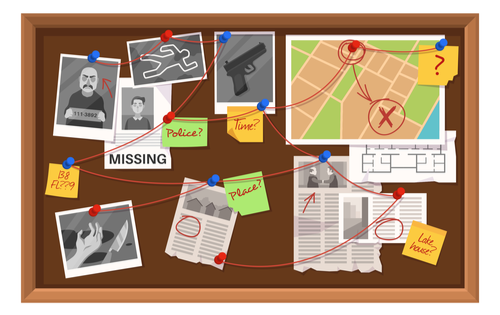
Time is ticking and the stakes are high on the bragging rights for cracking the case. The Lead Investigator will walk your Detectives through the crime scene, the evidence, interrogation videos, and more, then send them off in teams to discuss the case. While digging through clues with their colleagues, your crew will flex their communication and problem-solving skills to figure out “who done it?”
What does this group improv activity support?
- Employee engagement
Why this improv game is great for your team: This virtual improv game was designed to connect your remote associates. Get everyone engaged with some analytical thinking, made fun.
Where to get started: Request an instant quote and get the investigation started.
2) Coworker Feud
“play family feud with your coworkers for virtual team building fun.”.
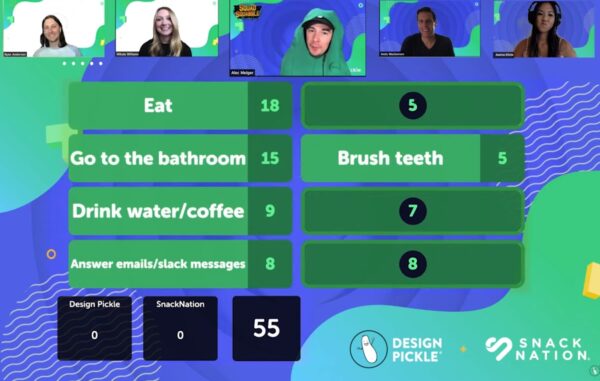
It may not be Steve Harvey hosting but you’ll have a fabulous facilitator to help your teams navigate the rounds in this virtual game show. Randomize your coworkers’ families or choose the teams ahead of time for them. Either way, everyone is sure to enjoy a little healthy competition and a bucket of laughs.
Why this improv game is great for your team: This improv game is great for virtual team building with a heaping bonus of laughs and fun for your whole group. Plus, if you want to keep it all relative, you can customize the questions to your industry.
Where to get started: Survey says, click here for more information about a Coworker Feud night to test your improv skills.
3) Virtual Mash-Up
“customize this event to match your own team’s dynamic”.

This online improv competition also makes a great warm-up game. A live host guides and entertains your team through several games, designed to loosen up any crowd. With so many ways to customize this event, you can ensure maximum engagement while they share some laughs with their coworkers.
- Company culture
Why this improv game is great for your team: It keeps the energy high and the vibe light. Work is hard enough – shake it up and have some fun!
Where to get started: Get started on customizing your next event’s icebreaker or plan a virtual improv game night .
4) Virtual Charades
“if you want to get your team on their feet, charades is an excellent option”.
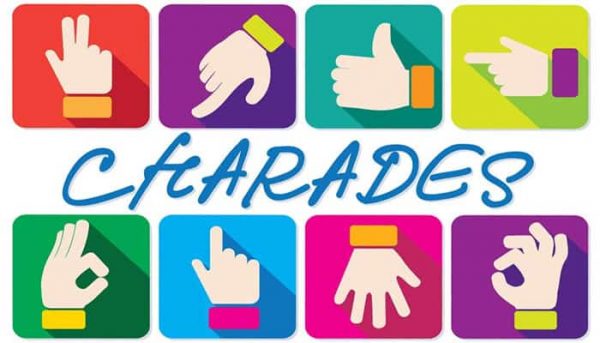
The childhood game you know with a modernized twist. Charades isn’t just a long-time favorite icebreaker, it’s now an interactive Zoom drama game. Random words are generated for your teams to act out and the others to guess – no verbal cues allowed. The team with the most points in the end wins the title of “Office Champ.”
- Social interaction
- Remote work culture
Why this improv game is great for your team: Having face-to-face time is even more important in this new remote environment. These interactions promote healthy relationships and deeper social connections, especially while working apart.
Where to get started: Get your team together for a night of charades !
5) Laughter On Call
“let’s laugh together”.

An entertaining host/comedian keeps everyone engaged, while dishing out some much-needed comic relief. Coordinate with your team, maybe grab some cocktails (servers not included), and make it a virtual improv party. After all, laughter is the best medicine.
Why this improv game is great for your team: Everyone can appreciate a good improv comedy show but in this interactive version, there are no audience members, only participants. Robert Orben said “If you can laugh together, you can work together” and this hilarious experience definitely promotes both.
Where to get started: Bond with your team over shared laughter and improv exercises.
6) Virtual Taboo
“often times more difficult than you’d expect, but always lots of fun”.
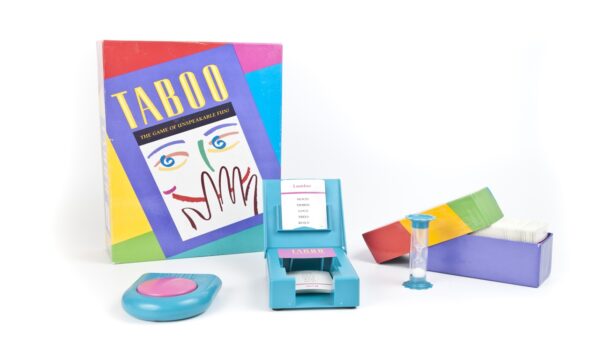
You’re probably familiar with the phrase “use your words” but this virtual improv game puts that skill to the literal test. Your team will take turns describing the first word on each card without using any of the Taboo words and phrases on the no-no list. Improv is all about laughs and this online game definitely delivers.
- Communication
Why this improv game is great for your team: The mobile-friendly platform makes it simple for group play . Real-time competition, in an online improv game for your team.
Where to get started: Check out a preview of this fun group improv game so your team members can start taboo-ing.
Improv Games For Large Groups
7) shark tank, bring your best pitch to the table.
Your group will be split into teams and sent to breakout rooms with their colleagues, where they’ll brainstorm a funny or clever invention and develop a mini-pitch to present to “the investors.” Once their pitch is over, they’ll all come back together in the main room to share their hilariously genius ideas.
Why this improv game is great for your team: This game allows their imaginations to drive the conversations and the fun. The possibilities are endless and so are the laughs.
Where to get started: Customize your event and start exploring all the creatively crazy ideas your team comes up with.
8) Werewolf
“face off with your coworkers as villagers versus werewolf”.

If you’re looking for a mystical escape for your team’s virtual improv night, look no further. There’s plenty of adventure to be had, while battling werewolves, taking on evil villagers, and figuring out each other’s secret identities. Who will win control of the town?
Why this improv game is great for your team: Everyone plays a character or creature in this magical mystery game, yet no one knows who or what their colleagues are. Let your group show off their strategic thinking skills with a side of suspense and shocking reveals.
Where to get started: Customize your adventure and immerse your villagers in a fantastic fantasy world.
9) Change The Channel
Lights camera action freeze.

Have your crew put on their showbiz hats and roll with the punches in this super funny theatre game to play on Zoom . Members of your team are given a scene and when the director says “Action!” the Oscar competition begins. When they hear “Freeze!” everyone stops, an actor is replaced by a new cast member, and a brand new (completely unrelated) scene is started.
Why this improv game is great for your team: Each of your team members gets to create a dramatic scene of their choosing but in the end, the bloopers are always the best part. Especially the ones where one person starts laughing and it catches like wildfire.
Where to get started: Check out some examples and more information here .
10) Party Guests
Guess the celebrity party guests.
A “room” full of mystery celebrities and one host designated to put names with all the impressions. Each of your team members chooses a celebrity and attends a virtual party in character. The guests enter the party one at a time, making conversation with the host who has thirty seconds to chat with them and figure out who they’re trying to be before the next person enters the room.
Why this improv game is great for your team: Everyone’s bringing their best impressions to the party. Stumping the host (especially if it’s the boss) is the name of this game.
Where to get started: Designate your Party’s host and let the guessing games begin .
Improv Games For Small Groups
11) actor switch, musical chairs meets “whose line is it anyway”.
Broken out into small teams of actors, each is assigned a character to play (no improv class graduation necessary). As the scenario plays out, the director will randomly call out “SWITCH!” and they’ll have to immediately switch to one of the other actors’ positions and characters. The goal is to create a seamless transition, complete with personalities, quirks, accents, and all the other traits their coworkers previously displayed.
Why this improv game is great for your team: This game will test their listening skills. They’ll need to pay close attention to one other throughout the scene in order to quickly switch gears and run with the next character.
Where to get started: No props or costumes needed, just check out the demo .
12) Space Escape
“every kind of thinker-word nerds, passionate puzzlers, and math mavens-will have a chance to shine.”.

In this virtual escape room , your whole team becomes the crew aboard a spacecraft headed to Mars. Something suddenly goes wrong and they can’t land on the red planet! They’ll have to work together, racing against the clock to solve different puzzles, as they make their way through the virtual spaceship and ideally, to safety.
Why this improv game is great for your team: This improv game is a fantastic team building activity , made to get everyone involved. Each crew member has a skill that will come in handy as they unravel the layers of this galactic mystery.
Where to get started : Practice your improvisation in a virtual escape room setting .
Improv Games For Team Building
13) social shuffle, “every challenge is designed to inspire conversation and help build bonds between teammates.”.

This virtual improv game was made to encourage socializing among your team members. The discussions are themed to keep the conversations on track and flowing. Your teams will be chatting it up in no time and may even bond over common opinions and hobbies, but they’ll definitely share some laughs.
Why this improv game is great for your team: Learning about each other just by talking is so effortless. This platform drives the conversations to make the most of your team building event .
Where to get started: Get to know your coworkers in a fun and lively setting!
14) Hitchhiker
“you can save the improv game for the last 5 or ten minutes – to send them off with a bang.”.

Photo Courtesy of Berkeley News
Your team members pretend to be traveling in a car when they spot a hitchhiker (a.k.a. another coworker). They pick him/her up, only to discover their new passenger comes with some extreme quirks, like a super obnoxious laugh or maybe they’re a loud gum chewer. The initial passengers then have to exhibit all the same mannerisms and to the same extremes.
Why this improv game is great for your team: It’s a light and funny active listening exercise that’s also great for virtual team building.
Where to get started: Check out the details here and load up the virtual office car.
15) Guess Who?
“guess the photo and find out if you know your co-workers as well as you think you do”.

Your team members supply a few photos that reflect who they are without actually revealing whose they are. Confetti collects the photos and creates an entertaining and interactive display, presented by a live host. Your crew will then guess who the pictures belong to, while learning a little about each other in the process.
Why this improv game is great for your team: Guess Who? is great for your hybrid or fully remote team set-up. If a picture’s worth a thousand words, then several of each coworker will certainly spark some conversation.
Where to get started: Guess who should click here to start customizing their team building game night? (Yes, you!)
16) Contact Word Game
“a witty group game that needs no props or a special setting nor does it have any time constraints.”.

Courtesy of CampFire Hacker
Imagine hangman with a bit of a twist. One player chooses a word in their mind and reveals the first letter. The other players try to guess, but also need to listen to the guesses from their coworkers. If one of them is getting close and throws out a synonym to see if they’re on the right track, the first player who hears this clue calls out “Contact!” and the word battle begins.
Why this improv game is great for your team: There’s no investment necessary and the game can be fully customized for your crew. This team builder helps build up their vocabulary and creates tighter bonds within your group.
Where to get started: Check out this demo video for all the details on how to get this improv team building game started for your group.
People Also Ask These Questions About Improv Games For Work
Q: what are group improv games for team building.
- A: Group improv games for team building typically promote collaboration and teamwork, and test your group’s active listening and communication skills.
Q: What are some unique drama and theatre games for teams?
- A: Some unique drama and theatre games for teams are “Actor Switch,” “Change The Channel,” and “Party Guest.”
Q: How do I choose an online improv activity for a meeting?
- A: To choose an online improv activity for a meeting, consider the various personalities and quirks of your team then choose an option that’s engaging for everyone. The list of improv game options above is a great place to start.
Q: How do I know if my virtual improv night was successful?
- A: To know if your virtual improv night was successful, simply ask your team if they found your improv exercise valuable. They’re feedback is the best input.
Interested in a content partnership? Let’s chat!
Get Started

About SnackNation

SnackNation is a healthy office snack delivery service that makes healthy snacking fun, life more productive, and workplaces awesome. We provide a monthly, curated selection of healthy snacks from the hottest, most innovative natural food brands in the industry, giving our members a hassle-free experience and delivering joy to their offices.

Popular Posts
Want to become a better professional in just 5 minutes?
You May Also Like

45 Best New Employee Welcome Kits, Boxes, & Packages For Onboarding In 2024
🎄15 Best Holiday Team Building Activities for Teams in 2024
One Comment
These are some really GREAT ideas! Surely will help an organization in so many ways.
Leave a Reply Cancel Reply
Save my name, email, and website in this browser for the next time I comment.
SnackNation About Careers Blog Tech Blog Contact Us Privacy Policy Online Accessibility Statement
Pricing How It Works Member Reviews Take the Quiz Guides and Resources FAQ Terms and Conditions Website Accessibility Policy
Exciting Employee Engagement Ideas Employee Wellness Program Ideas Thoughtful Employee Appreciation Ideas Best ATS Software Fun Office Games & Activities for Employees Best Employee Engagement Software Platforms For High Performing Teams [HR Approved] Insanely Fun Team Building Activities for Work
Fun Virtual Team Building Activities The Best Employee Recognition Software Platforms Seriously Awesome Gifts For Coworkers Company Swag Ideas Employees Really Want Unique Gifts For Employees Corporate Gift Ideas Your Clients and Customers Will Love
© 2024 SnackNation. Handcrafted in Los Angeles
- Recipient Choice Gifts
- Free Work Personality Assessment
- Happy Hour & Lunches
- Group eCards
- Office Snacks
- Employee Recognition Software
- Join Our Newsletter
- Partner With Us
- SnackNation Blog
- Employee Template Directory
- Gifts For Remote Employees
- ATS Software Guide
- Best Swag Vendors
- Top HR Tools
- Ways To Reward Employees
- Employee Appreciation Gift Guide
- More Networks
- Privacy Overview
- Strictly Necessary Cookies
- 3rd Party Cookies
This website uses cookies so that we can provide you with the best user experience possible. Cookie information is stored in your browser and performs functions such as recognising you when you return to our website and helping our team to understand which sections of the website you find most interesting and useful.
Strictly Necessary Cookie should be enabled at all times so that we can save your preferences for cookie settings.
If you disable this cookie, we will not be able to save your preferences. This means that every time you visit this website you will need to enable or disable cookies again.
This website uses Google Analytics to collect anonymous information such as the number of visitors to the site, and the most popular pages.
Keeping this cookie enabled helps us to improve our website.
Please enable Strictly Necessary Cookies first so that we can save your preferences!
- Virtual Experiences
- In-Person Experiences
- Hybrid Experiences
- Attend a Demo
- Experience FAQ
- Features & Benefits
- How Pricing Works
- Client Testimonials
- Happiness Guarantee
- Schedule Call
- View Experiences
#1 Free Improv Prompts, Topics & Scene Generator
By: Angela Robinson | Updated: March 12, 2024
You found our list of the best improv prompts and topics to act out.
Improv prompts are random scenarios for improvisation activities. For example, “holiday mascots on criminal trial” or “a family booking a vacation to space.” The purpose of these topics is to give actors a starting point for unscripted sketches. These ideas are also known as “acting prompts”, “improv starters” and “improv suggestions.”
You can use these starter questions during large group improv exercises , fun theater games , or Zoom improv activities .

This list includes:
- funny improv scenarios to act out
- improv ideas
- improv topics
- improv scene ideas
- drama scenarios to act out
- improv situations
- improv examples
- improv character ideas
- improv ideas for two
Here we go!
Random improv scene generator
We made this handy improv prompt generator to come up with scene ideas for improvisational activities. You can also ask for audience suggestions to come up with scenarios for sketches.
Funny improv prompts
- You suspect that your new boss is secretly a vampire
- Chaperoning a school trip to an amusement park
- Holiday mascots on criminal trial
- A writing team trying to think up new fortunes for fortune cookies
- A family booking a vacation to space
- Staff meeting at a zoo for mythical creatures
- The first meeting of an unlikely fan club
- An award ceremony with bizarre awards
- Grand opening of a restaurant gone wrong
- Halloween store employees packing up bizarre and unsold costumes
- Surprise birthday party where the guest of honor is late
- Birthday party for a 300 year old
- An open house at a clearly haunted house
- College orientation for unlikely majors
- Fairytale characters at a speed dating event
- Guide leading a tour through the weirdest museum ever
- Career day full of made-up jobs
- Interviews for a poison-food taste tester
- A group of time travelers from the past in a grocery store
- Paparazzi hired to take wedding photos giving instructions to the bridal party
- Wedding where all audience members object for ridiculous reasons
- If Willy Wonka ran a factory full of healthy foods
- An exercise class for action movie stars
- If history books were written like tabloid magazines
- Celebrity secret Santa
- A time traveler from the past is a contestant on “The Price is Right”
Random improv prompts
- Support group for evil henchmen
- Band of thieves planning an unlikely heist
- Genie who can only grant wishes that the whole group agrees on
- Pitching movie ideas to an executive
- A passenger suddenly realizes they are on the wrong flight as the plane takes off
- Attending a funeral for a rich person’s pet
- Future archeologists trying to explain everyday objects from present day
- PR team trying to rebrand a misbehaving celebrity
- Meeting a significant other’s family for the first time
- Family reunion
- Pirates hunting for buried treasure
- Driving class
- Group of superfans camping out in line
- Parents watching kids play on the playground
- The unlikeliest music festival ever
- If social media existed during important moments in history
- Auditions for a talent competition
- The waiting room at a plastic surgery clinic
- A haunted office
- A group of boy scouts or girl scouts trying to earn modern-day merit badges
Serious improv prompts
- A family reunites after a long time apart
- Saying goodbye to loved one at the airport
- A group of older folks share the lessons they wished they had learned sooner
- A group support group shares their biggest life regrets
- An employee made a major mistake and must tell their boss and team
- A group of executives negotiates a business deal
- A customer service team tries to solve a problem for a disgruntled customer
- A sales team tries to win back an unhappy client
- A team of detectives tries to solve a murder
- A group of patients waits in an ER waiting room
- A team of negotiators strategize how to solve a hostage situation
- A jury debates whether or not a defendant is guilty
- A group of strangers stranded at the airport talk about their destinations
- A group participates in a mediation
- A group strategizes how to survive a natural disaster
- A group stranded on a deserted island sets up camp
- A team confronts a team member who was caught lying or stealing
- A boss responds to employees who are upset and panicking over rumors
- A group says goodbye to and thanks a retiring employee
- Group has to deliver difficult news
- Group diffusing a bomb
Improv scene ideas
- A person auditions actors to pretend to be their family members
- Famous movie couples go to couples counselling
- A group of literary characters wonder into a bookstore and discover their own stories
- A group of contractors arrive to renovate a gingerbread house
- A family moves into a furniture store display
- Filming how-to videos for simple tasks
- An evil villain transforms world leaders into toddlers
- A team suddenly speaks different languages
- Superheros adjust to retirement
- A broken teleporter transports a group to random locations
- Tryouts for new cereal mascots
- A realtor tries to sell famous fairytale character homes
- A genie grants wishes to pets
- Snow White gets an office job
- White House staff briefs a new president on the country’s biggest secrets
- Cave parents confront their children about drawing on the walls
- Astronauts explore a new planet
- If pessimists wrote horoscopes
Improv scene opening lines
- “You got the stuff?”
- “I told you that was a bad idea.”
- “Are you sure about this?”
- “You will never believe who I ran into.”
- “You gotta help me!”
- “Follow that car!”
- “What did you do?”
- “I have never been so offended in all my life!”
- “Of all the people in the world, why does she have to date him ?”
- “This is a stickup!”
- “Good morning class, I am your substitute teacher.”
- “Do you have the time?”
- “What year is it?”
- “Where am I?”
- “You disgust me.”
- “You have a lot of nerve!”
- “You must be the new guy.”
- “Is this your first time?”
- “I can explain everything.”
- “I would like to file a police report.”
- “What are you doing here?”
- “Where were you last night?”
- “You must think I am pretty stupid.”
- “This is the best day of my life!”
- “Tell me you have good news.”
- “The results of the presidential election are in.”
- “Reporting to you live from the scene…”
- “This is not what it looks like.”
- “Can you do me a favor?”
- “Hold this for a second.”
- “Did you see which way he went?”
- “How do you know the bride and groom?”
- “I need a refund.”
- “Are you going to answer the phone?”
- “He proposed to you where?!”
- “Did you hear that?”
- “You look ridiculous.”
- “Why the hurry?”
- “Fire!”
- “How much is this going to cost me?”
- “What is the diagnosis, doctor?”
- “I didn’t do it, I swear!”
- “Let me show you how it is done.”
- “I never thought I would find you again!”
- “Thought you tricked me, did you?”
- “Do you have any idea how expensive this is going to be?”
- “There will be grave consequences if you choose incorrectly.”
- “Are you really going to wear that ?”
- “Why do you want to work here?”
- “I did it! I solved the mystery!”
- “Can you keep a secret?”
- “I knew you would be back.”
- “Well, well, well, what do we have here?”
Improv setting ideas
- Space station
- Meeting room
- Art gallery
- Amusement park
- Haunted house
- Sports stadium
- Job interview
- Reality show
- Orientation
- Fashion show
- High school
- Movie theatre
- Escape room
- Dressing room
- Grocery store
- Doctors office
- Lawyers office
- Police station
- Ice cream shop
- Parking lot
- Middle of the ocean
- A foreign country
- A fictional universe
- Battlefield
- Coffee shop
- Fast food restaurant
- Drive-thru window
- Middle school dance
- The Olympics
Improv character ideas
- A detective with amnesia
- A parent who has misplaced their baby
- Lottery winner
- Game show host switching careers
- An alien trying to blend in with humans
- A dog that can suddenly speak English
- A clown who gets mad when people laugh at him
- Window cleaner who is afraid of heights
- Character from a musical who does not understand why no one breaks out into random song and dance with them
- Survivor of a horror movie
- Historian who makes up fake stories
- Statistician who cannot stop quoting statistics
- Person who mistakenly thinks they are on a hidden camera prank show
- Dancer who denies that they are currently dancing
- Clumsy bartender
- Person who misquotes famous sayings
- Old-timey detective
- Rom com protagonist who falls in love with everyone she talks to
- Person who only gives one word answers
- Fortune teller making predictions
- A preschool teacher
- Aging rockstar
- Narrator who does not know other characters can hear them
- Superhero with strange superpower
- Person possessed by a series of different ghosts
- Child genius
- A preteen that makes innuendos out of everything
- Person who brags about being able to do completely normal things
- Video game character in the real world
- The worst advice columnist in the world
- Mad scientist
- Salesman who cannot stop selling things
- Person who is allergic to strange things
- An interior designer for supervillain lairs
- Sleepwalker
- Mermaid in disguise
Final thoughts
Improv activities can loosen up a group, sharpen quick-thinking and reaction skills, and speed-up team building. However, it can be difficult to think up unique and interesting scene ideas. Using pre-made improv prompts can save time and help actors jump into the scene. Once you act out a few ready-made situations, the audience may even feel comfortable shouting out scenarios. However, you are welcome to use the improvisation generator any time your teammates have a brain block.
Next, check out this list of icebreaker games , this truth or dare generator , and this list of the best improv books .
Book wildly fun team building events with expert hosts

FAQ: Improv prompts
Here are answers to common questions about improv prompts.
What are some good improv prompts for team building?
Some good improv prompts for team building include a writing team trying to think up new fortunes for fortune cookies, game show host switching careers, group diffusing a bomb, and superheroes adjusting to retirement.
How do you think of opening lines for improv activities?
To think up opening lines for improv activities, ask audience members for ideas or use an improvisation prompt generator.

Author: Angela Robinson
Marketing Coordinator at teambuilding.com. Angela has a Master of Fine Arts in Creative Writing and worked as a community manager with Yelp to plan events for businesses.
Leave a Reply Cancel
Your email address will not be published.

Marketing Coordinator at teambuilding.com.
Angela has a Master of Fine Arts in Creative Writing and worked as a community manager with Yelp to plan events for businesses.
- 45,000+ clients including Apple, Amazon, Google and NASA
- 50,225+ five star reviews on Google
- #15 on Inc 5000's List of Fastest Growing Private Companies in America for 2022
- 80+ happy remote employees
We lead wildly fun experiences for teams with 1,000,000+ players to date.

4.96 / 5.0 rating on
50,225 Google Reviews
Get our free team building tool box
$49 value at no cost..
- May as well check it out?
- 100+ tested icebreaker questions
- 24+ themed Bingo generators
- 5+ PDFs (including the 8% Rule)
- 2024 team building calendar and more...

Enter your email for instant access


How Improv Games Improve Collaboration and Communication
Learn to use fun improv games to foster teamwork and help staff members develop better communication skills.

Improvisational comedy isn’t new although it was widely popularized by the show “Whose Line Is It Anyway?” in recent years. In performance art form, improv dates back to the 16 th century’s commedia dell’arte. Today, you can catch improvisation shows at comedy clubs, theaters, and even some coffee shops and boutique stores.
Improv games are typically based on the rule of “yes, and.” That rule encourages support of ideas through immediate agreement, with other participants add on to the original premise of the scene. It’s unusual for improv to allow for opposition or judgment because all of the people involved are agreeing with and acting on each other’s input in a positive manner.
Book a Team-Building Improv Workshop
Let’s Roam offers 20+ proven activities to help businesses build more bonded teams. When you sign up for an improv workshop , Second City veterans will engage your group and get those creative juices flowing. Improv helps encourage communication, breaks down barriers, and fosters teamwork. These comedy games will have your crew laughing it up while they learn!
Reasons to Use Improv Games at Work
Recently, some organizations have incorporated improv exercises into their team-building activities. Following the yes, and rule fosters participation and prevents people from being afraid to share their ideas.
Engaging your team in some improv exercises can reap significant benefits for your team, such as:
- Enhanced creativity
- Increased empathy
- Better adaptability
- Improved communication and collaboration
- Elevated brainstorming
- Improved listening skills
Infusing positivity into your workplace with some improv comedy can pay off in other ways, too. For example, a “yes, and” attitude that’s demonstrated through improv can breed trust and camaraderie, which can make your team a lot stronger.
If you have new employees in your group, you can use some improvisation games to help them feel welcome as they get to know their new coworkers. Improv games are highly effective ice breakers that are inherently a lot of fun and often quite hilarious.
Are you trying to help your team work better together? If so, we encourage you to schedule some outdoor team-building activities with Let’s Roam. We thrive with a “yes, and” attitude and it shows in the team-building activities we’ve put together. Sign up to bring your team together now.
Improv Games for Your Team
If you’re eager to see your team enjoy the benefits that improv can provide, you might find yourself looking for a list of the best improv games online. There’s no reason to scour the internet, however, because we’ve already found the best improv exercises for you and your team.
“Yes, and” isn’t just a philosophy that drives improv. It’s actually a game you and your coworkers can play. Your team can play Yes, and as a whole group or you can have two people play in a pair as the rest of your group looks on.
Have the first person say something to another actor. The actor spoken to should respond with, “Yes, and” and then add something based on what was initially said. Let the game continue in this manner for several minutes. As you’ll quickly realize, this improv game is great for strengthening a team’s collaborative skills.
Word at a Time
Word at a Time usually begins with you saying, “Once upon a time,” and pointing at the next person you want to add to the story. The person you point at will then add one word to the story. From there, contributions will come from the next employee on the right or left and the game will continue going around the circle. This game encourages creativity and free-flowing communication, but players have to stay in the moment and remain attentive.
Yes, Let’s is an improv game that’s as simple as it gets. To start, have one person name an activity. After the person shares their chosen activity, everyone else responds by saying, “Yes, let’s.” The responders then act out the activity for ten seconds or so before the next person identifies a different activity. The game should continue until everyone’s had a chance to shout out an activity.
If you’re trying to find an improv exercise that’s a good warm-up game or ice breaker, you’ve succeeded. Yes, Let’s will have even newly introduced coworkers sharing laughs and pleasantries in no time.
Location, Location, Location
Location, Location, Location is similar to Charades in that it requires players to employ their acting skills. Like Charades, this game is a great one for large groups. To start, have the first person think of a location that’s familiar to your whole group. Then, instruct the person to act out that location without saying what the place is.
As the person is acting out their chosen location, audience members try to identify the location and shout out their guesses. The person who guesses the location first is the winner of that round.
Jabbering Jargon
Jabbering Jargon is exactly what its name implies, a word improvisation game. This fun game centers around one person and requires audience participation.
To start, pick one person who’ll then call out words that aren’t associated with each other. The moment the person strings two words that are related to each other in succession, the audience will call the individual out on it. Then, the next person will try their hand at stringing words together until they make the mistake of using two related words back-to-back, and so on.
Problem and Solution
Like the other exercises on our list of improv games, Problem and Solution is easy to play in physical and virtual environments. This game is best played in pairs, with the first player being player A and the last person acting as player B.
Player A gets things going by identifying a problem, a fictional or actual problem will do. Player B then gets a nearby item and offers it as the solution to the previously stated issue. Without hesitation, player A recognizes the object and proceeds to explain how the item will solve the problem. Once a round is done, the players should switch roles and play again.
This improv exercise helps players to think quickly and adapt to what might be unexpected situations. Imagine telling your coworker that your faucet is leaking, and your teammate presents a ream of paper as the solution. How would you explain that? You’d have to think fast and adapt your answer to your coworker’s unusual, proposed solution.
Zip, Zap, Zop
Zip, Zap, Zop is a game that’s rife with built-in silliness. The first player kicks things off by clapping, saying “zip,” and naming the next contestant. The second player claps, says “zap,” and names a third player. That player will then clap, say “zop,” and name a fourth coworker who will start the whole process over with zip. If someone messes up the zip, zap, zop order, they earn a strike. When a player earns three strikes, they’re out of the game.
Want to plan an activity that will have your team zipping and zapping around town? Contact Let’s Roam to let our talented team create a custom scavenger hunt for your group. Learn what you should bring to an outdoor scavenger hunt now!
Active Audience
Active Audience requires 1-3 participants to act as storytellers, with the rest of their group being active audience members. One of the storytellers will start a story with a line like, “I enjoy Mexican food, but my favorite thing to eat is…” at which time onlookers will shout out crazy things, such as “baseball glove” or “dog poop.” The storyteller will pick one of the things the audience shouts out and incorporate it into the next line of their tale.
The story can continue for as long as you like. In fact, it might go on for hours, with things only getting funnier as you go along. You might find your team exchanging jokes related to this game for months after you play it. That’s how riotous a game of Active Audience can be.
Rumor Has It
Rumor Has It is a wonderful warm-up game that will get the figurative ball rolling in your next team meeting. Have someone kick things off by telling a coworker something. The person spoken to will affirm the rumor they were just told, add their own twist to it, and then relay their version of events to another teammate. The game will continue like that until everyone’s had the chance to add to the original rumor.
One possible exchange might be…
Player one: Did you hear that Mary likes to drink lemonade in the morning?
Player two: Did you hear that Mary likes to drink lemonade in the morning but only when she’s wearing her pink slippers?
Player three: Did you hear that Mary likes to drink lemonade in the morning but only when she’s wearing her pink slippers and her hair is in a ponytail?
Imitation is a breeze to play. Set an order for your coworkers to go in if your team is remote or stand in a circle if you’re in the office. Kick things off by performing some type of action and pair it with a sound. The next player will then try to imitate your action and utterance as will the player after that person. The further along the line your action and sound go, the more distorted and hysterical they’ll invariably become.
If you want to do something your teammates will want to imitate over and over again, try to implement some tips to improve your remote employee engagement . When your team is fully engaged, they’ll get even more out of improv games and want to follow the example you set. Of course, improvisation exercises already require participants to be fully engaged so you’re already well on your way to improving your team’s engagement. Keep it up!
Stop, Go, Face, Clap
Stop, Go, Face, Clap is a great improv game that tests participants’ active listening and self-awareness skills. Appoint someone to be the facilitator. That person will tell other players what to do using the words included in the game’s name.
Here are the meanings of those words as they relate to the game:
- Stop: be still in place
- Go: pretend to walk
- Face: make a funny face
- Clap: clap your hands
Have the facilitator switch between activities slowly at first. As the game progresses, the facilitator should change activities more often. Your facilitator should randomly toggle between activities so participants can’t detect a pattern.
Players who can’t keep up with the facilitator’s instructions are eliminated until just one person remains. That person is the winner.
Alien, Tiger, Cow
The goal of Alien, Tiger, Cow is for all participants to eventually end up making the same hand gesture without coordinating verbally. Count down from three and have everyone make a hand gesture after you say “one.”
Participants can choose from among three gestures. Holding two fingers up represents an alien’s antennae. A claw refers to a tiger while a closed fist is reminiscent of a cow’s udder.
Unless your team nails it on the first try, you should repeat your countdown and have your coworkers try again. Continue repeating the process until your teammates all use the same hand gesture.
Alien, Tiger, Cow is a low-pressure warm-up. It’s also a nice introduction to getting your team to think like one.
Group Counting
Group Counting is similar to Alien, Tiger, Cow in the sense that it requires participants to work together. The purpose of this game is for your team to count to 21 as one. The catch is that your coworkers will have to count with their eyes closed and only one person is allowed to speak at a time. Each player can only share one number per turn, which will prevent anyone from grabbing the initial spotlight and doing all the counting themselves. If two people speak simultaneously, the game starts over.
Despite being simple to play, reaching 21 is a surprisingly difficult task for many teams. That’s because employees don’t have the added benefit of seeing visual cues like someone opening their mouth to say the next number. Group counting is a great exercise to practice verbal cue interpretation and to develop a group mindset.
Three-Headed Expert
Three-Headed Expert involves three team members acting as one expert. Once you’ve pieced your expert together, audience members should ask the expert questions. Your three-headed expert should answer each question one word at a time while rotating through its three heads. When your expert has given its full answer, one of its heads will wave a hand to indicate that’s the case before the expert moves on to another question.
If your expert is having difficulty falling into a pattern with answers, you can help out. Instruct the expert to repeat a person’s question using the one-word, rotating format before answering it until the expert gets into a rhythm.
Last Word, First Word
Active Listening is a key component of effective communication and collaboration. Last Word, First Word is one of the most fantastic improv games to exercise your team’s active listening muscles.
To play Last Word, First Word, someone will say a sentence. The next player will then add a sentence using the last word in the previous player’s sentence. Players are eliminated if they can’t come up with a line that starts with the last word in the previous sentence. The last person left as a player will be the winner of the game.
Pass the Face
Pass the Face is entertaining for in-person group play and it’s just as much fun to play online. The first person starts by making a face and showing it to the next player. The second improviser then mimics the original face and makes another one, which is then shown to a third player, and so the game continues. While playing Pass the Face isn’t exactly rocket science, the game does create greater awareness, which is necessary for improved collaboration and communication.
Emotional Guessing Game
If your team has experience with improv, you may want to take a stab at the Emotional Guessing Game. Divide your team into pairs. Have player A act out an emotion without speaking while player B attempts to interpret what that feeling is. Once player B reads player A’s emotion correctly, the two players should switch roles and repeat the game.
If a player is struggling to portray a given emotion, encourage the participant to draw on their own personal experiences. By doing so, your employees will get to know each other better and build trust.
Frequently Asked Questions
Improv games such as “Stop, Go, Face, Clap” and “Pass the Face” are great for large groups. Exercises that seem like they’re limited to small groups can usually be adapted to accommodate big teams.
Some improv activities require props, but most don’t. Typically, you don’t need anything but willing participants to play James like Pass the Face, Three-Headed Expert, and Rumor Has It.
As often as you can! When you see the benefits of improv exercises , you’ll likely want to schedule them more frequently. These team-building activities will help your group communicate and collaborate.
Need help planning a team-building event?
Schedule a quick, complimentary 15 minute chat with an event planner to book your next team building event with breeze., featured products & activities.
Practice improv over Discord video chat!

Game of the Scene Workshop
Learn a step-by-step method professional improvisers use to make their scenes funny.

Improv Games Library
Browse a library of short improv games and exercises that will make you a better improviser and storyteller.

Story Games
Play some fun storytelling-focussed improv games.

Improv Prompts
Improv prompts and suggestions generator.

10 Easy Improv Games for Beginners
Starting out as an improv beginner can be intimidating. I remember walking into my first improv open play and wondering if I’d be able to keep up…or make a total fool of myself. But the improvisers organizing the event knew great improv games that are welcoming for beginners just starting out. Whether you’re teaching an intro to improv class or just trying to include accessible games for everyone, these games are great for improvisers of all levels.
Here are ten of the best improv games for beginners:
- Yes, Let’s
- I Am a Tree
- 3-Line Scene (with “Yes, And”)
- The Ad Games
- Pass the Clap
- Alien, Tiger, Cow
- Group Counting
- One Word at a Time Story
- Fortunately, Unfortunately
- Three-Headed Expert
While low-pressure large group games and warmups are common go-tos for improv novices, it’s also important to think about the building blocks of becoming a better improviser. The following list includes beginner-friendly games and warmups that focus on several key improv skills: accepting and agreement, group mind, and storytelling.
Improv Games for Accepting and Agreement
Agreement is one of the fundamental tenets of improvisation and a crucial foundation for any scene. These group-focused improv games don’t keep the attention on any one person for too long, so they’re great for beginners. And, they also focus on listening to others and responding with clear and explicit agreement.
1. Yes, Let’s
How to play: Yes, let’s is a great improv warmup game since everyone can be involved, and the focus is never on one person alone. To start, everyone begins walking around the room, mingling without following any particular path. Then, someone yells out a suggestion for what the group should do, typically involving physical movement, such as “let’s hop like bunny rabbits” or “let’s go scuba diving.” Everyone else enthusiastically yells “yes, let’s!” and the group proceeds to do (or pretend to do) that action until a new person calls out a suggestion (e.g., “let’s bake chocolate chip cookies”).
Why it’s great: The enthusiastic agreement (yes, let’s!) is the key to this game. It brings up the energy level in the group and reaffirms one of the key tenets of improv: no matter how weird or unexpected a suggestion is, in an improv scene, you need to agree with the reality your scene partner has established.
This warmup game also gets people moving around the room and doing big physical movements, which can feel especially awkward for new improvisers (it definitely felt awkward for me at first). By engaging everyone in this movement at once, people are less likely to feel self-conscious.
2. I Am a Tree
How to play: In this game, three people create a scene-picture with their bodies. The first person proclaims that they are an object and positions their body to mimic that object. For example, they might stick out their arms like branches and say “I am a tree!” Then, anyone from the group can jump in and become an object that goes with the first object. For example, person B could say “I am a squirrel in the tree” and crouch down like a squirrel, or they could say “I am a pile of fallen leaves,” etc. A third person then jumps up and completes the scene (“I am a rake”). Once the three-person scene picture is complete, the third person remains onstage as the same object, and two more people jump in to create a completely different set of related objects.

Why it’s great: This game requires improvisers to agree with their scene partners by choosing objects that go with/fit the already established scene. There’s no pressure to say any dialogue, so it can be easier for newer improvisers to jump up and put themselves out there.
3. Three-Line Scene (with “Yes, And”)
How to play: Three-line scene is a classic improv exercise for a reason, and playing this game with a “yes, and” requirement makes it even better for beginner improvisers. Two people create a mini scene in three lines, where person A begins the scene with any line, and person B responds with “yes, and…” and adds on to what person A has put out there. Person A then finishes the scene with another “yes, and” statement. If possible, avoid asking questions.
Person A: I made you a bologna sandwich. Person B: Yes, and it’s the third one you’ve made me this afternoon. Person A: Yes, and I’m trying to distract myself since you’re going away to college today.
As the group plays this game, you can add on requirements to build more fleshed out mini scenes: establishing the who, what, or where of the scene in those three lines, for example. You can eventually dispense with the phrasing “yes, and” while still making sure you agree with and add to everything your scene partner says.
Why it’s great: This game is not only great practice for quickly establishing the who, what, and where of a scene, distilling the elements of a scene to its most abbreviated form–it’s also a great way to practice agreement. It’s some times easy to focus on the yes part of “yes, and,” but this game forces improvisers to build on/add meaningful details to what their scene partner says.
4. The Ad Game
How to play: This game is played in groups of 3 or more. You start with a suggestion for a type of product (a chair, a phone, a shoe), and the group will work together to flesh out the details of a revolutionary new product they’ve invented. To start, someone in the group makes a statement about the object (“This shoe has well-supported arches”). Everyone enthusastically yells “yes!” like this is the greatest idea in the world. Then, another person says “and” and contributes another detail (“And its laces are magnetic so they never come undone when you’re running”).
Repeat this process, building on and enthusiastically agreeing with everyone else’s contributions until you have a fleshed out product and identified a name for your product, a tagline, and a celebrity who endorses your product. At this point, allow the group to confer together for a few minutes, after which they will improvise a commercial for their new product.
Why it’s great: This game requires good listening and agreement, and the enthusiastic response (“yes! and”) to every idea is affirming, reinforcing the idea that improv scenes are built collaboratively, with everyone contributing ideas. Even ideas that don’t seem exciting or flashy contribute to building the reality of the scene (or, in this case, product). And the final product is always bigger and better because of the cooperative way it’s formed.
Beginner Improv Games for Group Mind
Group mind can be difficult to define, but you know it when you see it. Being on the same page with your fellow improvisers takes time, effort, and great listening skills. These improv exercises are great for beginners and experts alike, and they focus on connecting with your teammates, listening closely, and being present in the moment.
5. Pass the Clap
How to play: Have everyone stand in a circle facing each other. The goal of the game is to pass the clap from one person to another. To do this, whoever starts person eye contact with someone else in the circle, and both people must clap their hands at the same time, maintaining eye contact. Once they do so, person B now has the “clap.” Person B then makes eye contact with someone else, and they clap simultaneously.
As people get used to the game, speed up how quickly you’re passing the clap, or have someone else start a new clap, so that two claps are being passed at the same time.
Why it’s great: This game involves everyone at once, which reduces the pressure on any one person, and it requires you to focus and be hyperaware of what the other improvisers in the circle are doing. The faster you go, the more you need to be in sync with everyone else in the group, so you can clap simultaneously without messing up.
6. Alien, Tiger, Cow
How to play: This easy improv game makes a great warmup and is good for younger improvisers as well. Everyone stands in a circle, you count down (3…2…1), and then eveyone must simultarnosuly make one of three motions: alien (holding two fingers up next to your head like atennae), tiger (making claws with your hands), or cow (using one hand to make an udder in front of your stomach).
The goal is for everyone to make the same motion at the same time. The countdown repeats, and everyone makes a motion again, trying to get the whole group on the same page: alien, tiger, or cow. You repeat this until everyone makes the same sign.

Why it’s great: This game is easy to learn but requires improvisers to be observant of others and get on the same wavelength. It’s a great, low-pressure warmup for practicing group mind.
7. Group Counting
How to play: The instructions for this game are deceptively simple–just count to 21 as a group. The catch: only one person can speak at a time, you have to close your eyes (so no pointing to who will speak next), and if two people speak at the same time, you have to start over again from 1.
Why it’s great: This game is harder than Alien, Tiger, Cow because you have to get on the same page with your fellow improvisers without any visual cues. While this game is often frustrating, it is great for listening closely, picking up on verbal cues, and working on a sense of group mind in general. And it’s so satisfying when you finally get to 21.
Improv Games for Storytelling
Story-focused games can be a great way to practice working together as a group, developing characters, and remembering what your fellow improvisers said two minutes ago. These low-pressure storytelling games allow new improvisers to practice these skills without putting them on the spot.
8. One Word at a Time Story
How to play: Just like it says on the tin, in this game, everyone stands in a circle and tells a story together, but each person can only say one word at a time. The goal is to tell a cohesive story with a beginning, middle, and end, with characters and a clear setting. But you have to get on the same page as everyone else and listen carefully since you can only say one word at a time.
Some people like to bookend the story with “once upon a time…” and “the moral of the story is…” This wraps up the story explictly and requires the group to reflect on a loose theme for thier made-up tale. This optional, though. As an improv game for beginners, you can recommend they start in the middle of the action, rather than starting with “once upon a time.” Another great idea is to ask the group to act out/mime their story as they tell it, which also helps keep the story action-focused, without spending too much time on setup.
Why it’s great: This game not only practices good storytelling in a low-pressure way (having clearly identified/named characters, a setting, a conflict and resolution, etc.), but also forces people to listen and react in the moment. You have to develop some group mind as your story gains momentum since no one person can direct where the story goes.
9. Fortunately, Unfortunately
How to play: The structure of this game is simple: One player makes a statement starting with “fortunately” (e.g., “Fortunately, I got the accounting job I applied for”), and then the next improviser continues the narrative with an “unfortunately” statement (e.g., “Unfortunately, the job is in Antarctica”). This cycle of fortunately-unfortunately continues until the “story” reaches some kind of resolution.
The example above could continue like this:
Person A: Fortunately, my coworkers were a bunch of adorable penguin accountants. Person B: Unfortunately, they always ate raw fish for lunch, so the office stank. Person C: Fortunately, I was able to introduce them to sushi, which got me brownie points with my coworkers. Person D: Unfortunately, one of the penguins got sick from the sushi and blamed me. …. And so on.
Why it’s great: This deceptively simple game reinforces several key elements of good torytelling in imrov: making sure that what you say follows from and builds on what came before (yes, and), active listening, and sensing, as a group, where a story is headed and when it’s over.
10. Three-Headed Expert
How to play: This game requires three improvisers who will all act as one, three-headed expert. The audience will ask this expert a series of questions (anything from “how do I get my girlfriend to stop snoring?” to “what is the meaning of life?”), and the expert will answer–with each person speaking one word at a time. When the expert’s answer is finished, the three “heads” will all wave their hands to signify that they’ve finished answering. Then, they take on the next question.
Why it’s great: This game uses a lot of the same skills as one word at a time story. It requires three people to get in the same mindset as one person and to collectively feel when a question is sufficiently answered. Answering discrete questions can also feel less daunting than starting a story from scratch. One tip is to have improvisers start by repeating the question, so they gain momentum talking one word at a time before they have to create new material. For example, “The way to get your girlfriend to stop snoring is…”
These are all games that I enjoyed and learned from as a beginning improviser, and they’re improv games I play today. What sets these games apart, in my opinion, is not that they’re “easier” or more simple than “advanced” improv games. The truth is, we’re all still learning, so I’m not sure that distinction is useful. It’s that these games reinforce fundamental improv skills that many new improvisers want to build on, and they do so in a low-pressure way that isn’t as daunting as some other improv exercises.
Happy improvising!
Improvisational Comedy Admin
I'm an improv enthusiast and student based in Denver, Colorado, who wanted to create a website to share improv tips, games, and insights with other people who love improv comedy.
Recent Content
Musical Improv Solo Tips: How to Nail An Improvised Solo
Improvising a solo is pretty daunting, but when you pull it off, it leaves both you and the audience a bit in awe that you managed to pull together a complete song by yourself..and one that...
Improv Object Work: 6 Mistakes to Avoid
Object work is something I've found incredibly difficult as an improviser. It takes a lot of work and skill to create an imaginary physical environment in the midst of your scene, interact with...
Welcome to Improv world!
Unleash your inner performer, think on your feet, and create unforgettable moments of laughter and spontaneity with the electrifying world of improvisation.

Friends & Family
- Practice empathy with ones you care
- Foster a Sense of Play and Childlike Wonder
- Quality and fun time together

- Get to know each other better
- Break Down Social Barriers
- Improve Emotional Intelligence

- Improve Communication Skills
- Build Confidence
- Build Resilience and Adaptability
Why you should try it
It's fun.
Playing improv games is an endlessly entertaining and hilarious way to unleash your creativity and spontaneity while connecting with others.
Easy to start
With no need for props or special skills, improv games are a breeze to start playing anytime and anywhere with just a few willing participants and a willingness to have fun.
Always different
From the unexpected twists and turns to the unique energy and ideas brought by each player, every experience of playing improv games is an adventure full of surprises and laughter.
Any ages are welcome
No matter your age or background, the inclusive and playful nature of improv games makes them a perfect activity for anyone looking to unleash their creativity and have a blast with friends, family, or strangers.
For small and big companies
Whether you're looking to break the ice at a party, bond with coworkers, or entertain a crowd, improv games are a versatile and adaptable activity that can be played with small or large groups of people, making them the perfect choice for any occasion.
Can be played offline and online
Thanks to their flexible and adaptable nature, improv games can be enjoyed both online and offline, allowing you to have fun with others no matter where you are.

Battledecks
It is an exhilarating improvisation game that puts participants in the spotlight. Player is given a set of unseen PowerPoint slides filled with bizarre and unrelated content. With no time to prepare, they must deliver an impromptu presentation, seamlessly incorporating the unexpected slides into a coherent and entertaining narrative.

Story, Story, Die
In this exhilarating improv game, performers stands before a host, waiting for their turn to shine. As the host directs their finger, a seamless story unfolds, with each improviser picking up where the last left off. Laughter, suspense, and unexpected twists fill the air as the narrative grows, leaving only the most quick-witted and imaginative to carry the tale forward. It's a thrilling experience that showcases the magic of spontaneous storytelling and the power of collaborative creativity.

Blind Interview
You believe interviews are stressful? How about Blind Interview? Here's how it goes down: we pick a random victim, er, interviewee who has to play along and pretend that they know which job they're applying for. We pick a random profession from a list, and the rest of the team grills the interviewee with questions like they're a pro at hiring. The catch is, they have to make it seem like they're interviewing for a totally different job than the one they actually applied for. It's like a guessing game, but with more laughter and less pressure.
I have always been interested in humour, did some StandUp Comedy, but didn't even imagine how easy and bright Improv is, comparing with other types of comedy. 0 preparation + immediate start makes it my "No-brainer"

Grigori Paslari
Engineering Manager @HeliosX
I've got a new powerful tool in my toolset of team games to improve public-speaking and team spirit while having fun. Love the immediate availability of all key elements of the game which pushes my preparation time down to close to 0

Evgheni Smeshnoi
Project Manager @Endava
It was an amazing experience with friends. I thought that improvisation only for actors, but it end up being super easy to start and super fun to play. No more boring discussion "About nothing", just improv!

Marina Paslari
Web Designer @Easy Improv
Home » Games » 10 Interesting Improv Games
10 Interesting Improv Games
Improvisational theater is a form of theater in which all of the actors perform without a script, practice, or even at times, a plot. Everything they do is unscripted, and of course, spontaneous. Watching improvisational theater – simply called improv – can be a load of fun. Needless to say, trying improv first hand can be even more entertaining.
Table of Contents
If you want to recreate those hilarious scenarios from Whose Line is It Anyway, then here are some fun improv games you can try with your class, your friends, or your family.
Dub a Foreign Film
If you were hoping to try a few fun improv games for beginners, this one’s a great start. Give each member of your group a turn to play the role of foreigner or dubber, with four people playing during each round.
How to Play:
- Two of the participants will play the role of foreigners in a film. In a scene where they pretend to have a conversation with one another, these players will speak gibberish and act with exaggerated expressions and hand movements.
- The other two players will dub the scene with lines that they feel would most appropriately fit the first two players’ acting.
- Fun and simple, this hilarious improv game can give you hours of unprecedented laughs. Try to come up with the best scenes and give everyone a chance to play so each person get’s the chances to improve their skills.
Scenes From a Hat
This is a fun improv game idea from the popular 1998 TV show, Whose Line is It Anyway? practices your players’ ability to whip up fun, quirky, entertaining short scenes to challenge their wit and quick thinking.
- To start the game, have everyone think of an idea for an improve scene and write each one down on separate slips of paper. For example, a suggestion might be “the most daring way to quit your job”, or “something you can say that will always start a fight.”
- Have each player come up with 5 or more suggestions and toss them all into a hat. Then, as the game master, pull one out per round and read it out to the players.
- Players should take turns to act out their scene, but there is no structure as to who goes first or last. It all depends on who wants to act out during that scene suggestion. Players who want to pass can skip their turn.
A Word at a Time
If you’re dealing with a group that’s yet to become acquainted, then you might want to start off with a game that isn’t too difficult. A Word at a Time is a great way to warm up your players, giving them an easy yet effective improv experience that will expand their comfort zone so they can take part in the games more willingly.
- To play this game, simply instruct your participants to sit in a circle. The objective is to come up with a cohesive story line.
- To do that, players can only add one word at a time. So you go around the circle, asking each player to add one word to the story as they move along.
- The game ends when you come to a conclusion for your story. So keep on going around the circle to complete your tale and see how funny and outlandish the outcomes can be!
Sound Effects
Here’s an oldie but a goodie. The Sound Effects game is a classic improv game that’s loads of fun and laughs.
- Essentially, players will only be provided the basic idea of the story they’re acting in. It can be anything you can think of, like ‘grandma’s 95th birthday’ or ‘the national clown convention.’
- Tell your participants to incorporate as many actions and invisible props as possible – preferably things that make sounds. And then assign a number of the group to stand by, watch, and make the sound effects for these imaginary props as the story unfolds.
- It can be loads of fun because there are no rules when it comes to providing the sound effects. For instance, a dubber can meow as one of the actors removes a sword from its sheath. There really are no rules – the more unexpected the sound effect, the funnier the scene becomes.
Mystery Box
This one’s a real challenge, making it the perfect game for those who have tried improv before.
- A box containing random objects is placed center stage. Two to five actors are given roles in a general story line. Somewhere down the story, they have to open the box by incorporating it into their tale. For instance, if they’re pretending to be pirates, they can pretend the box is sunken treasure.
- Actors aim to incorporate the random items in the box into their story. What makes it hilarious is that the items in the mystery box are often completely unrelated to the story, but actors are not allowed to pretend the items are anything other than what they are.
- For instance, actors pretending to be in outer space discover underwear in their mystery box. They can’t pretend that the underwear is a flag, a rag, or anything else. They need to incorporate it into the story as it actually is.
This fun game adds a touch of wit as players are required to guess what’s on the screen behind them after the whole charade. Two players are designated the role of correspondent while one other participant takes the role of rookie reporter out on the field. The rookie reporter is also the player who gets to make the guess at the end of the game.
- This game requires a projector or a screen playing a random video clip behind the rookie. It starts off with the correspondents reporting a news bit from the ‘news studio’. These players – and the rest of the audience – can see exactly what’s being shown on the video clip.
- They start the report by giving the rookie some clues as to what’s being shown. For instance, in a random clip of baby penguins, the correspondents can say something like, ‘It looks pretty cold down there, rookie!’
- The rookie’s objective is to try to come up with a flash report talking about what’s in the video even if they can’t see what’s being shown. They use cues from the correspondents to come up with an idea as to what clip is playing.
- At the end of the game, the rookie is given the chance to guess what they think was in the clip. If they’re able to formulate an assumption before the game ends and they start reporting on the right topic, then the game is automatically stopped and the rookie wins!
Strange Part Guests
Similar to News Flash, this game involves one player who makes guesses to win the game. There can be as many as 10 players, but for beginners, you might want to involve just 4 others along with the player who makes guesses.
- The mechanics are simple – each ‘party guest’ is given a role. It can be a unique identity or a quirky fictional persona. For instance, one guest will be given the role of The Mad Hatter from Alice in Wonderland, while another plays the role of a hungry hippo inspired by the popular board game.
- No other players should know what the others are pretending to be. The last player is designated the guesser and party, and their objective is to guess what or who all the other players are. They can try to figure that out by talking to each guest at the party.
- To start, each party guest walks into the scene one by one. The party host greets each one at the door. From the moment the guest walks in, all the way to the end of the game, they have to be in character.
- Once the party host figures out who they are, they can call out their guess. If they guessed it right, that party guest gets to leave the party and take a seat with the audience. If not, then the host will have to keep trying. The game ends when the time is up or when the host is able to name each party guest.
Where’s the Remote?
Another fun bit, Where’s the Remote involves five players. Two pairs are designated actors on a TV screen, while the 5th player gets to hold the ‘remote’. To start the game, players are given a list of scenes that they can play out. The 5th player shouldn’t be aware of what theses scenes are.
- The game begins when the 5th player turns on the TV. Each pair of actors takes turns acting out one of the scenes on the list they’re given. They can’t use any sounds and they can’t talk, but they are encouraged to be as expressive with their gestures and movements as possible. The 5th player’s task is to call out what he thinks the players are acting out.
- Once he makes the right guess, he changes the channel and the other pair of actors come on screen, acting out their scene from the list they were given.
- The game goes on like this, with the pairs taking turns whenever the 5th player guesses right and changes the channel. The game ends when all the scenes on the list are finished up.
This fun game challenges the imagination, making it a really fun game for both audience and players. Two teams are given strange props – preferably random foam shapes that don’t really have a particular use. The more obscure the items or shapes, the better.
- The teams are given one different prop each to work with and they take turns coming up with scenes. It can be a hoot especially because the props will often only barely resemble what the actors are trying to use them as.
- Players are also encouraged to use a few phrases to give context to their scene and make it easier for the rest of the audience to figure out what the prop is being used as.
- For example, one pair puts their prop – a big u-shaped piece of foam – on the ground. Both players examine it and one goes, ‘This is the biggest horse I’ve ever seen.’ to clue the audience in that the piece is used to represent a horseshoe print in the scene.
- Teams take turns coming up with random bits using their designated props until the time is up.
Paint Me a Picture
As one of the many fun improv games for kids and adults, pain me a picture starts off slow, with just one player taking center stage. Their objective is to pretend they’re in a specific scenario or environment. This can be anything they want it to be, but it has to be something that everyone is familiar with.
- They act in this environment, performing activities and miming tasks that a person would do in this type of setting. The player can’t speak or make sounds throughout the entire act.
- As the audience watches on and the players start to figure out what the actor is trying to depict in the scene, they can join in and pretend they’re also a part of the environment.
- The game goes on like this, until all of the players figure out what the original environment was. As each one decodes the scene, they join in and become a part of the setting.
- All actors should maintain the environment, avoiding to do anything that would disrupt what’s happening or change the original setting as the first player intended.
Final Thoughts
Improv games can be a load of fun. Challenging your creativity, wit, and humor, you can have hours and hours of laughter with your class, your friends, or your family with this interesting game format. For teachers trying to hone their students’ acting and confidence, then improv games can be instrumental. So don’t forget to pack these games along the next time you’re dealing with your class to help encourage them out of their shells of shyness and make them feel more comfortable just letting loose every now and then.
Susan majored in English with a double minor in Humanities and Business at Arizona State University and earned a Master’s degree in Educational Administration from Liberty University. She taught grades four through twelve in both public and private schools. Subjects included English, U.S. and world history and geography, math, earth and physical science, Bible, information technologies, and creative writing.
Susan has been freelance writing for over ten years, during which time she has written and edited books, newspaper articles, biographies, book reviews, guidelines, neighborhood descriptions for realtors, Power Point presentations, resumes, and numerous other projects.
Read full bio
Related posts
Leave a comment cancel reply, recent posts, 31 unique company picnic ideas (+games & activities).
August 15th, 2024
30 Fun Classroom Games (For Students & Kids)
August 1st, 2024
33 Perfect Social Skills Activities (For Kids, Teens, Adults)
July 15th, 2024
24 Inexpensive Employee Engagement Ideas
July 1st, 2024
28 Best Teacher Appreciation Week Ideas
June 15th, 2024
30 Best Coach Gift Ideas [for Any Sport]
June 1st, 2024
109 Challenging Chicago Trivia & Facts
May 15th, 2024
- Games, topic printables & more
- The 4 main speech types
- Example speeches
- Commemorative
- Declamation
- Demonstration
- Informative
- Introduction
- Student Council
- Speech topics
- Poems to read aloud
- How to write a speech
- Using props/visual aids
- Acute anxiety help
- Breathing exercises
- Letting go - free e-course
- Using self-hypnosis
- Delivery overview
- 4 modes of delivery
- How to make cue cards
- How to read a speech
- 9 vocal aspects
- Vocal variety
- Diction/articulation
- Pronunciation
- Speaking rate
- How to use pauses
- Eye contact
- Body language
- Voice image
- Voice health
- Public speaking activities and games
- Blogging Aloud
- About me/contact
- Activities and games
- 5 improv games
Improv games - warm-ups & icebreakers
5 fun speech & drama activities to start a class.
By: Susan Dugdale | Last modified: 10-21-2023
Here's 5 fun improv games that were class favorites when I was teaching high school speech and drama.
They're great exercises that combine learning about mental flexibility, focus, communication, concentration, body language and empathy, with good fun.
Try them as icebreakers or warm-ups: - quick fire activities to get your class or group focused and ready for work.
Be warned - the first two are riotously noisy!
1. Hares and Hounds
You'll need a hall or a gymnasium to play this one as it needs a largish space. The game always worked well for me regardless of age group. It's a load of loud fun!

Instructions
- Split your class into two equal teams.
- Line them up in front of you with about a two metres between them.
- Instruct them to face one another. Each person should now be opposite another - their partner for the exercise.
- Name one team Hares and the other Hounds .
- Call for silence.
- Explain you will call either Hares or Hounds.
- Depending on which you call, people in the named team must tag their partner BEFORE they make it to safety on the side of the hall behind them. (Note: If the space is very large, that is the side walls are a long way from the middle of the room, mark out boundaries.)
The key is in the silence before calling, and then in split second reactions. The team tagging runs straight ahead toward their partner but the team to be tagged must turn around before they run.
Make sure no one stands too close to their partner. The two meter space between the lines must be there before calling the name of the team that tags.
You'll be amazed by how many players get confused and bewildered and run in the opposite direction!
After they've got the exercise sorted, flummox them completely by calling another animal or word beginning with H for example, horse, hippo, or heffalump .
Change the names the next time you play to Rabbits and Roosters and then call Raddish !
2. Murder (Yes, looks can kill!)

You'll find this game an excellent icebreaker for groups of 5 players plus. It encourages bold, exaggerated responses - the bigger, the better.
- Sit your class in a fairly tight circle on the floor.
- Tell them to drop their heads (' Heads Down ') and close their eyes.
- While their heads are down tell them to choose a person to fixedly stare at when you call ' Heads Up '. They may not choose someone directly on either side of them. Anyone other than that is fine.
- Call ' Heads Up '. If any player finds them their stare reciprocated, that is met by another, both players must scream loudly and 'die'.
- Once players are 'dead' they leave the circle.
- Close the circle up again and start again by calling ' Heads Down '.
- Play several rounds applauding new methods of dying - gurgling, choking, weeping etc.
- Vary the time between your calls to heighten tension.
And now for 3 quiet improv games:
This exercise is borrowed from mime, best done in a hall, is good for people of all ages and for maximum impact needs to be done in silence.

I'm sure you're familiar with the saying, but have you actively tried copying exactly how another person walks? This is a fascinating, illuminating exercise enabling a glimpse into what it is really like to be in another person's shoes.
Participants will discover what it feels like to go through the world for example, with their head down, with rounded shoulders, head up, without lifting their feet ... Whatever is observed in their partner they will attempt to copy.
- Split your group or class into pairs.
- Ask one person of a pair to start walking how they naturally or normally would.
- The second observes for at least 10-20 seconds before following them copying to the very best of their ability everything the first does when they walk.
- After a several of the laps of the hall, have the first person stop and watch the second who will keep walking in the style of the first.
'Walk As' is great for observing where weight is carried, which part of the body leads, and what emotional/mental shifts occur in the second person to accommodate the walk of the first. It takes HUGE focus to do it well.
Change partners several times to have your group experience being in a variety of other people's shoes.
Have a feedback round to finish.
4. The Naming of Things
This game The Naming of Things is brilliant for concentration or focus and only works if each person is thoroughly in the 'now'. It makes us aware just how deeply embedded our associations with words are!

Tell your class to walk authoritatively around the work space naming everything they see as something other than what it is. They must point to the object as they declaim its new name.
Example: 'A' sees the floor, points while loudly exclaiming 'dog'.
When they get proficient do the exercise with a drum beat to set a walking pace. Strike 1-2-3-4 and then pause in which the class names something as something else and then pick up the beat again.
For variation try - faster and slower beats plus varying the number of beats between the pauses.

This is another of those improv games borrowed from mime and therefore is best done in complete silence. When I played it if there was any verbal communication , the group had to begin again!
You're going to tell your class to line up according a range of differing criteria.
Start with obvious physically observable criteria for example, from smallest to tallest, or shoe size and then move to more difficult ones, for example, lining up alphabetically according to the first letter of their middle name, or by birthday (date and month).
Allow about 3-4 minutes to complete the task and tell them to sit down in order when they're satisfied they've got it right. You then check the results.
There will be bad mime in all directions but it's a great exercise for focus!
Using improv games in public speaking classes
Even though these are essentially drama exercises, I think they are a useful addition to teaching public speaking. The line between the skills required for either is very blurred. Both share performance in front of an audience as an end goal.
A good public speaker needs what these improv games offer: an awareness of body language and non-verbal communication, while developing concentration, mental agility and flexibility, confidence and empathy.
And if you're teaching a public speaking class ...

You'll love my book!
A complete one stop resource for teachers to scuttle their students' public speaking fear in the best of all possible ways - with laughter!
What other teachers say :
"Thank you so much for making my class fun, and not scary!"
"My students are 8th graders - a tough crowd to engage but these games are working very well."
"Your materials provide great structure and content examples."
Make your speech class fun too. Find out more >>
For more freebie public speaking activities
- word games to stretch imaginations, develop confidence and impromptu speaking skills
- 7 public speaking games for middle school and upward
- Return to top of improv games
speaking out loud
Subscribe for FREE weekly alerts about what's new For more see speaking out loud

Top 10 popular pages
- Welcome speech
- Demonstration speech topics
- Impromptu speech topic cards
- Thank you quotes
- Impromptu public speaking topics
- Farewell speeches
- Phrases for welcome speeches
- Student council speeches
- Free sample eulogies
From fear to fun in 28 ways
A complete one stop resource to scuttle fear in the best of all possible ways - with laughter.

Useful pages
- Search this site
- About me & Contact
- Free e-course
- Privacy policy
©Copyright 2006-24 www.write-out-loud.com
Designed and built by Clickstream Designs
- Grades 6-12
- School Leaders
Have you gotten your free poster delivered? ✨
5 Improv Games for Any Content Area (Except Possibly Math)
Get kids out of their seats and engaged with these fun classroom improv games.

I was a big improv comedy dork in college. (My memoir will be titled I Never Said I Was Cool .) I tried out for a comedy troupe my freshman year, somehow made it, and that was my social milieu for the next four years. I wasn’t even that good, although I did manage to marry the funniest guy in the group a few years later. Regardless, my college improv experiences did not pave the way to fame. They did, however, make me a better teacher. I use improv games all the time in the classroom, mostly because I don’t like to actually write detailed lesson plans. Occasionally, I even let the kids do improv, and I’ve found through trial and error a few games that work pretty well to cover content or review.
1. Build Me a Bridge
I use this as a warmup on days when I need my kids to do focused work in groups, especially if they’ll be sitting a lot that day. They choose groups of three to six kids—and it’s important to let them choose their own groups here, because they won’t work with kids they don’t trust—and then I yell out an object and set a timer for one minute. They have those sixty seconds to use their bodies to create that object; a taco, a sailboat, or, you know, a bridge. Or whatever you come up with that seems funny. After a minute, they freeze and you pick a winner. If you want to make this more content focused, you can give them academic topics, like plant cells or To Kill a Mockingbird or whatever.
Disclaimer: My kids LOVE this game, and they would play it every day. It’s a great chance for your introverts to emerge as leaders, since a lot of kids have these crazy spatial reasoning skills that, as a language arts teacher, I rarely get to see. But I’ve never played it during an observation because it involves a lot of touching between students and also because I’m afraid the one time my principal watches will be the time a kid gets a concussion. Because this game gets rowdy .
2. Campfire Story Vocabulary Review
For this game, the kids all sit in a big circle with a list of the vocabulary words you’re reviewing. You choose a kid to start off a story, that kid says one sentence, then the kid next to him or her says a sentence, and so on around the story. Each sentence has to correctly use a vocabulary word. If your kids are having trouble with this, try making them use starters like “fortunately,” “unfortunately,” or “meanwhile.” It’ll add a little structure to the activity and help the more hesitant kids along. If the story ends before you run out of students/vocabulary words, they can always start a new one!
3. Questions
Traditionally, this game is between two performers, each of whom can only speak in questions. I’ve used it with great success in sixth grade to teach declarative, imperative, interrogative, and exclamatory sentences. I give each kid a piece of paper with his or her type of sentence, they get a scenario—“You’re at a party”—and they have a dialogue in which they can only use their type of sentence. I’ve done it with less success in seventh grade with simple, compound, and complex sentences. I don’t know how you’d use it in science or social studies, but I’m sure there’s a way!
Disclaimer: You want volunteers for this game; if you cold-call on kids, they’ll get up and just stand there and it will kill your class momentum. Just remember, there’s no shame in bribing kids to volunteer for something. Also, it works best if you’re a performer in the first couple of rounds to help the kids along.
4. Party Quirks
This is a guessing game. One player is designated the host and leaves the room while you assign characters to the other three players. These three players can be historical figures, literary characters, scientists…whatever your kids need to review. Once each character has been assigned, the “host” comes back in and begins preparing the party. One at a time, your “guests” enter and try to drop subtle hints about their character. (“Well, this party is evolving nicely,” says Charles Darwin. Boo Radley hangs out creepily in the corner.) The host’s job is to guess who each character is.
Disclaimer: This is another one where you want willing participants, and I’d play in a round or two first if I were you. It’s probably going to flop spectacularly a few times before it gets off the ground, so don’t think you’re doing something wrong if that happens. This is a tough skill.
5. Free Form Conversation
Put a bunch of names in a hat. Or you could use cell parts or planets or something science-y like that. Two kids get onstage and the rest of the class gives them a location. Then they each pick a name and play that character in a scene that takes place in that location, i.e. Macbeth and Tom Joad hanging out in a karaoke bar. You stop the scene when it starts either dying or getting inappropriate.
Disclaimer: This works best with higher level kids. Also, some kids will never be willing to play this game. And that’s okay. I wouldn’t make it mandatory, since this is some kids’ worst nightmare. ADVERTISEMENT
There are other games I use in the classroom, but these are the easiest to start with. While they don’t work for every class or every kid, once the kids get the hang of it, they’re a great way to review.
Do you use improv in the classroom? I’d love to add some new games to my repertoire, so please share in the comments!

You Might Also Like

Start Early with Statistics Instruction
You're already doing it ... here's how to connect the dots. Continue Reading
Copyright © 2024. All rights reserved. 5335 Gate Parkway, Jacksonville, FL 32256
- Meeting Transcription
- Meeting Note Taker
- Meeting Recording
- Headphones and Devices
- Audio Quality
- Tips and Best Practices
- Meeting Apps
- Meeting Templates
- Remote Work
- Contact Centers
- Accent Localization
- Engineering Blog
Top 70 Virtual Team Building Activities & Games for Fun
10. Celebrate Successes
How krisp makes online team building ice breakers productive & effective, frequently asked questions.
Spread the word
Imagine you sipping your morning coffee and logging into another virtual meeting. But instead of diving straight into business, you’re greeted with virtual team building activities — a trivia quiz, a virtual escape room challenge, or perhaps a light-hearted game of charades.
These online team bonding activities aren’t just time-fillers; they’re powerful tools designed to foster collaboration, boost morale, and build trust among team members.
Let’s dig deeper into the world of the best virtual team building activities and how your team can connect and engage remotely. Moreover, let’s reveal how AI Meeting Assistant Krisp can make your virtual gatherings far more productive, transforming your remote work experience.
What Are Virtual Team Building Activities?
Remote team engagement activities are also called team building activities virtual. They offer a creative and essential solution to engage, motivate, and connect remote teams worldwide.
And this is especially critical in today’s remote work environment that represents people from different locations and time zones.
Virtual team building activities range from simple virtual ice breakers to elaborate events. They aim to build trust, improve communication, and foster creative thinking. Because today, staying connected with your team is more critical and challenging than ever.
“How well people work together may be more important than how well they work on the tasks. The secret sauce comes from the teamwork,” says Gerald F. Goodwin, PhD in the Behavioral and Social Sciences.
Why Are Virtual Team Building Activities Important?
Remote work offers many benefits, such as flexibility, increased productivity, and a better work-life balance. However, it also comes with its own set of challenges. And the sense of isolation stemming from working alone, day in and day out, is one of the biggest challenges.
The good news is that virtual conferencing platforms like Zoom and Google Meet help combat this isolation. Moreover, Meeting Assistants like Krisp enhance remote collaboration, making virtual team building activities more fun and engaging.
Specifically, digital team collaboration games help team members:
- Form stronger personal connections, leading to effective collaboration and a more cohesive team.
- Enjoy a sense of belonging and community, which is vital for maintaining morale and motivation.
- Break from the daily grind, relax, and have fun together.
- Enjoy increased job satisfaction, reduced stress, and a stronger loyalty to the team and company.
So, the best answer to “How to have fun with a remote team?” is to engage in online team building exercises that create solid remote groups. Only strongly connected and engaged teams can achieve great things together.
How to Build Team Work Virtually?
As Suzanne Bell, PhD, an associate professor of industrial/organizational psychology at DePaul University, says, “Teams are complex systems. The more you can manage them using a scientific basis, the better your teams will be.”
To make virtual team building activities effective, consider the following strategies:
1. Align Activities with Team Goals
Choose activities that align with the team’s objectives and tailor them to your team’s needs. These objectives include improving communication, fostering creativity, or boosting morale.
Example: A Virtual Communication Workshop improves poor communication, boosting collaboration and alignment with overall team objectives. As a result, teams achieve active listening and clear messaging.
2. Use Short and Engaging Activities
Our attention spans are shrinking , especially regarding virtual attention spans. So, make your remote team bonding activities concise and engaging to maintain energy and focus. Specifically, ensure the sessions last 30 to 60 minutes.
Example: Use Virtual Icebreaker Bingo, which suggests filling out a bingo card with personal or fun facts (e.g., “Has traveled to more than five countries”). Participants ask each other questions to check off squares.
3. Utilize the Right Virtual Team Collaboration Tools and Technology
Make the technology used for remote team connection activities accessible and user-friendly. Additionally, use tools that enhance virtual interactions by eliminating distractions and creating a collaborative environment.
Example: Remote communication platforms like Zoom and Slack offer breakout rooms for small group activities, screen sharing for presentations, and collaborative tools like whiteboards or polls. However, you can use AI Meeting Assistants like Krisp to enhance group gatherings by Cancelling Noise and Automating Note Taking.
4. Ensure Everyone Is Included
All team members should feel included regardless of location, role, time zone, or technical ability. Encourage open communication and make it easy for everyone to contribute.
Example: In a Virtual Round-Robin Storytelling, each team member contributes a sentence to a story. Thus, this activity ensures everyone participates and adds their unique perspective, boosting engagement and creativity.
5. Make Your Team Building Virtual Activities Fun and Creative
Incorporate fun and creativity into your online team building activities to keep the team engaged. Why? Because fun activities help break the monotony of virtual meetings, leading to relaxed and open communication.
Example: Consider a Virtual Creative Brainstorming Challenge to foster creativity and fun collaboration. Namely, digital tools like Miro and Wrike can be used to brainstorm and create a visual project, like a mood board or concept art.
6. Encourage Participation, Avoid Pressure
Participation is essential. However, ensure team members aren’t pressured to participate in uncomfortable activities. Specifically, offer them various options to respect individual preferences and encourage voluntary engagement.
Example: Try Virtual Coffee Chats or Virtual Ice Breaker Questions . These are informal activities encouraging participation. They don’t force anyone to engage in high-pressure scenarios, creating a relaxed and supportive environment.
7. Follow Up for Feedback and Iterate
After each activity, gather participant feedback to understand what worked and what didn’t. Use this feedback to refine future activities, ensuring they become more effective. As a result, you can keep activities fresh and relevant.
Example: Send a short anonymous survey asking team members to rate their experience and suggest improvements. Next, review the feedback, discuss it in a team meeting, and adjust future activities based on their input. This way, you can ensure the activities remain relevant and enjoyable for the team.
8. Build a Routine for Virtual Team Building Activities for Work
Regularly scheduled virtual group bonding activities help build a routine and create anticipation among team members. Whether it’s a weekly virtual coffee break or a monthly game session, consistency helps reinforce team bonds.
Example: Schedule a 15-minute Virtual Team Check-In every Friday morning. This is a consistent, informal meeting, including a quick ice breaker and a casual discussion. It fosters regular connections and reinforces team bonds over time.
9. Use Breakout Rooms for Virtual Team Interaction
Consider breakout rooms to create smaller, more intimate groups where participants can interact more freely. Specifically, these rooms are great for larger teams as they facilitate deeper connections and ensure everyone can participate meaningfully.
Example: Use breakout rooms for small group discussions, allowing team members to collaborate closely. As a result, team members share ideas and build stronger connections in a more intimate setting.
Use virtual team building activities to celebrate team achievements and milestones. Recognizing success and expressing gratitude can enhance team morale and foster a positive team environment.
Example: After a successful group gathering activity, share a digital certificate, announcing the achievement during a team call. Or send a small gift or e-card to acknowledge everyone’s participation.
Now, let’s discuss free virtual team building activities and games that can help you boost team morale.
Fun Virtual Team Building Activities
- Virtual Escape Room: Solve puzzles and riddles together to escape a themed room within a set time.
- Online Trivia Night: Test team knowledge on various topics, from pop culture to history.
- Virtual Pictionary: Use an online whiteboard to draw and guess images as a team.
- Murder Mystery Game: Solve a virtual whodunit with your team by following clues and interrogating suspects.
- Virtual Cooking Class: Cook a meal with a professional chef’s guidance via video call.
Ten Not Lame Virtual Team Building Activities
- Virtual Happy Hour with Mixology Class: Learn to make cocktails with a professional bartender.
- Online Improv Session: Engage in fun, spontaneous activities that improve creativity and communication.
- Virtual Charity Challenge: Complete challenges together to raise money for a charity.
- Virtual Scavenger Hunt: Find and collect items around your home based on a list of prompts.
- Online Paint and Sip: Paint together while enjoying drinks, guided by an online instructor.
Ten Minute Virtual Team Building Activities
- Quick Fire Trivia: Answer rapid-fire trivia questions to see which team member knows the most.
- Two Truths and a Lie: Share two facts and one false about yourself for others to guess.
- Virtual Show and Tell: Show something interesting from your workspace and explain its significance.
- Emoji Story: Create a story using only emojis and let your team decipher it.
- Rapid Icebreaker Questions: Answer a series of quick questions to get to know each other better.
Five Minute Virtual Team Building Activities
- One Word Pulse Check: Share one word that describes your current mood or day.
- Speed Networking: Spend 2-3 minutes talking with a team member you rarely interact with.
- Desktop Background Tour: Show your desktop background and explain why you chose it.
- Virtual High-Five: Share something positive and give virtual high-fives for support.
- Mini Desk Scavenger Hunt: Find something on your desk that fits a specific category (e.g., something red).
Quick Virtual Team Building Activities
- Online Polls: Use a polling tool to gather opinions on fun topics quickly.
- Virtual Coffee Break: Take 5-10 minutes to chat over coffee or tea, just like an office break.
- Guess the Emoji: Describe an event or movie using only emojis and have your team guess it.
- Virtual Rock-Paper-Scissors Tournament: Play this classic game online with your team.
- Virtual Ice Cream Social: Everyone brings a bowl of their favorite ice cream for a quick chat.
Ice Breaker Virtual Team Building Activities
- Virtual Background Challenge: Use a fun or unique virtual background and explain its significance.
- “What’s Your Superpower?”: Share a unique skill or talent you have that’s unrelated to work.
- Themed Dress-Up Day: Pick a theme (e.g., 80s, superheroes) and dress accordingly for the meeting.
- Who’s That Baby?: Share baby photos and guess which team member they belong to.
- Virtual Bingo: Play a quick round of Bingo using fun, personalized categories.
Virtual Team Building Activities for Small Group
- Virtual Book Club: Discuss a short book or article, sharing insights and opinions.
- Online Meditation Session: Practice mindfulness with a guided virtual meditation.
- Virtual Coffee Roulette: Pair up randomly with a team member for a casual chat over coffee.
- Virtual Vision Board: Create and share vision boards to discuss personal or professional goals.
- Online Group Journaling: Share thoughts or reflections on a prompt, then discuss.
Virtual Team Building Activities for Large Groups
- Virtual Talent Show: Invite team members to showcase their hidden talents in a group video call.
- Large-Scale Online Trivia: Break the team into groups and compete in trivia across multiple rounds.
- Virtual Jeopardy: Play this classic game show format with categories tailored to your team.
- Massive Virtual Escape Room: Engage in an escape room accommodating large groups.
- Online Auction for Charity: Bid on fun items using fake money, with proceeds going to a chosen charity.
Unique Virtual Team Building Activities
- Virtual Field Trip: Visit a museum or historical site virtually and discuss what you’ve learned.
- Remote Time Capsule: Create a virtual time capsule with photos, messages, and videos from the team.
- Online Karaoke Night: Sing your heart out with your team during a virtual karaoke session.
- Virtual Travel Experience: Take a guided virtual tour of a city or country and share experiences.
- Virtual Escape to Nature: Watch and relax with live streams from national parks or nature reserves.
Christmas Virtual Team Building Activities
- Virtual Secret Santa: Draw names online, send gifts virtually or by mail, and then open them together.
- Christmas Movie Trivia: Use classic Christmas movies to test your knowledge in a fun quiz.
- Virtual Gingerbread House Competition: Build gingerbread houses and show them off on camera.
- Holiday Sweater Contest: Choose your ugliest holiday sweater to wear. Vote for the best one.
- Virtual Holiday Cookie Exchange: Share recipes and photos of homemade holiday cookies.
Holiday Virtual Team Building Activities
- Virtual Holiday Card Making: Create and share virtual holiday cards.
- Online Ornament Exchange: Swap ornaments via mail and showcase them on a group video call.
- Virtual New Year’s Resolutions: Share your resolutions and discuss how to achieve them as a team.
- Holiday Song Pictionary: Draw and guess popular songs using an online whiteboard.
- Virtual Hot Chocolate Social: Sip hot chocolate together while sharing holiday memories.
Virtual Team Building Activities at Home
- Home Office Tour: Give a virtual tour of your home office setup and share productivity tips.
- Show Your Pet Day: Introduce your pets to the team and share fun stories about them.
- Virtual Cooking Show: Cook a simple dish together while sharing tips and tricks from your kitchen.
- Online Puzzle Party: Work on a jigsaw puzzle together using a digital platform.
- Home Fitness Challenge: Compete in a fitness challenge that can be done in a home environment.
Easy Virtual Team Building Activities
- Virtual Coffee Chat: Take a few minutes to chat casually over a virtual coffee break.
- Online Team Playlist: Create a collaborative playlist with everyone’s favorite songs.
- Shared Photo Album: Create an online album where team members can upload photos.
- Group Doodle: Collaborate on a digital whiteboard to create a fun group doodle.
- Virtual Name That Tune: Play snippets of songs and have the team guess the title and artist.
Thanksgiving Virtual Team Building Activities
- Virtual Gratitude Circle: Share what you’re thankful for this year with the team.
- Online Thanksgiving Trivia: Test your knowledge of Thanksgiving history and traditions.
- Virtual Pie Bake-Off: Bake pies and share photos or videos of your creations.
- Thanksgiving Recipe Swap: Share and discuss your favorite Thanksgiving recipes.
- Turkey Hunt: Organize a virtual scavenger hunt with Thanksgiving-themed items.
Creative Virtual Team Building Activities
- Virtual Art Class: Learn to draw or paint with a professional artist guiding the session.
- Online Storytelling Workshop: Create and share stories as a group using creative prompts.
- Virtual Music Jam Session: Play instruments together or sing along in a virtual music jam.
- Digital Collage Creation: Collaborate on creating a digital collage representing the team.
- Virtual Photography Contest: Take and share photos based on a theme, then vote for the best ones.
Use Krisp to Enhance Virtual Team Building Activities
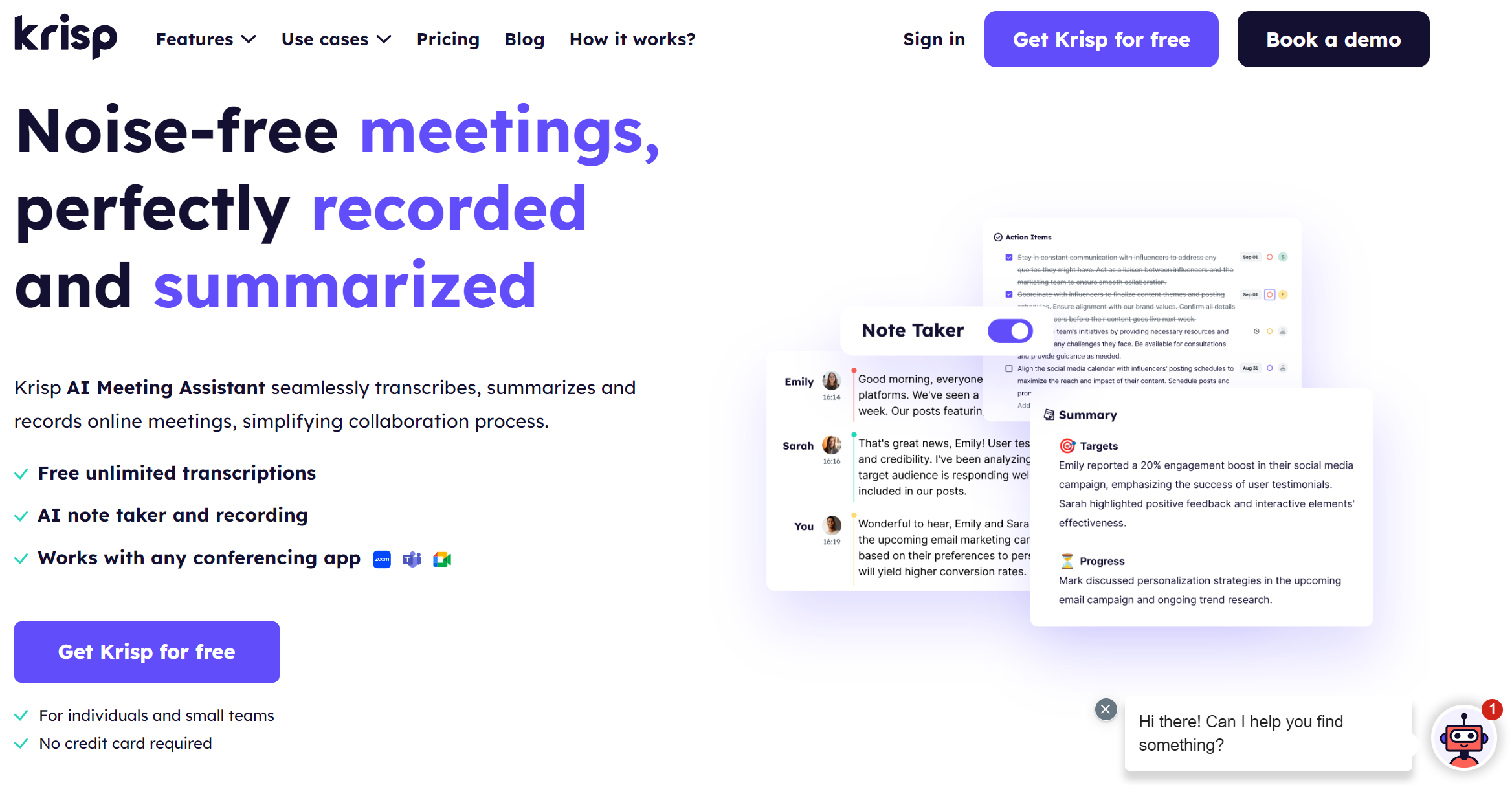
Remote team unity activities help teams bond by promoting personal interaction, breaking down barriers, and uncovering shared experiences. But what if you join a meeting and wish you could leave a moment earlier because of background noise?
That’s where AI Meeting Assistant Krisp steps in to eliminate background distractions and save your most essential discussions for future reference. As a result, Krisp enhances effective and meaningful connections even for geographically dispersed teams.
Today, Krisp processes 75+ billion minutes of voice conversations each month. This Meeting Assistant doesn’t bother you with lots of bells and whistles. Krisp relies on your computer’s microphone and speakers to Record Meetings. So, it doesn’t add a bot that may distract participants.
Feel free to use Krisp on Windows, Mac, Linux, iOS and Android. Moreover, Krisp is compatible with any videoconferencing tool like Zoom, Google Meet, and Microsoft Teams.
Let’s take a closer look at Krisp’s features:
Krisp Cancels Noise in Real Time
Krisp’s Noise Cancellation feature transforms your meetings from chaotic to crystal clear, effectively enhancing team cohesion, communication, and morale. Users note that Krisp’s noise suppression algorithm is ten times better than those built into Google Meet or Zoom.
As a result, this Meeting Assistant boosts engagement and collaboration among team members. And this results in increased productivity and loyalty to the company.
Krisp Records Meetings with Best-in-Class Audio Quality
Krisp Records Meetings using the highest audio quality. Moreover, Krisp doesn’t rely on joining calls because people often forget to allow it. This AI tool automatically Records Online Discussions so you don’t miss them.
As a result, you can save your Meeting Recordings to review and revisit them later without watching the entire recording. This improves teamwork and accessibility.
Krisp Automatically Transcribes Meetings Multilingually
AI Note Taking Tool Krisp transcribes online discussions in real time with 96% accuracy and stellar speaker recognition. Moreover, Krisp’s Meeting Transcriptions pull out critical information about all aspects. So, you don’t need to take handwritten notes for your digital engagement activities.
As a result, you can focus on what matters instead of taking notes manually. Thus, Krisp simplifies follow-ups, boosts efficiency, and reduces the risk of losing vital information.
Krisp Summarizes Meeting Notes Without Errors
Krisp brings peace of mind by Summarizing your remote team building activities so you can save the critical insights post-call. Importantly, Krisp Takes Call Summaries without personal biases and interpretations.
As a result, Krisp’s AI Meeting Notes feature fosters effective communication and follow-up actions. Thus, it helps you stay organized, informed, and far more productive.
Get Krisp for Free
Wrapping Up
Virtual team building activities are vital to remote work culture. Specifically, they help bring teams together, foster collaboration, and maintain a strong sense of community across distances.
Include these activities into your routine, helping your team stay connected, motivated, and engaged, regardless of location.
Importantly, use AI Meeting Assistant Krisp to enhance team building activities for virtual teams. Namely, Krisp provides clear communication, eliminates background noise, and takes exceptionally accurate notes. Thus, it makes teamwork smoother and more enjoyable.
What Are Good Virtual Team Building Activities? Good online group bonding activities include virtual escape rooms, online trivia games, virtual scavenger hunts, remote cooking classes, and collaborative art projects. These activities foster team bonding, enhance communication, and keep remote teams engaged and connected. What Is the 5 Minute Ice Breaker Activity?
A 5 minute ice breaker activity is a quick, engaging exercise designed to warm up group interaction. For example, consider “Two Truths and a Lie,” where participants share two facts and one falsehood, and others guess which is false.
Another example is “One Word Pulse Check,” where team members describe their current mood in a single word. These activities help build rapport and set a positive tone for the meeting. What Are the 5Cs of Team Building? The 5Cs of team building are Communication, Collaboration, Commitment, Competence, and Conflict Resolution. These principles foster effective teamwork by enhancing interaction, cooperation, dedication, skill development, and managing disagreements constructively. What Are Good Team Boding Questions? Good team bonding questions help team members connect personally, fostering stronger relationships. Here are five examples:
- “What’s your favorite way to spend a weekend?”
- “What’s the most interesting job you’ve ever had?”
- “Where would you go if you could travel anywhere?”
- “What’s one skill you’d love to learn?”
- “What’s your favorite team memory?” What Is a Fun Quick Ice Breaker? A fun, quick ice breaker is “Two Truths and a Lie.” Participants share three statements about themselves—two factual and one false—and others guess the lie. This activity sparks conversation and laughter, making it an engaging way to start a meeting.
Related Articles


COMMENTS
When first introducing improv to a group, simple games that center on having fun and eliciting laughter can really show the value of the process and encourage engagement. Hello Kitty is a short game that simply asks the group to try and make one another smile. Start by separating the group into puppies and kittens.
19. Mirrors. Here's an improv game for team collaboration that focuses on creativity, attention to detail, and enhancing the connection between colleagues. As the name suggests, it asks pairs of workmates to team up, face each other, and to imagine they have a double-sided mirror between them.
The game where you give the Powerpoint presentation of your life. Powerpoint Karaoke (also called Powerpoint Roulette or Battledecks) is an improv game where you give a presentation from a slide deck you've never seen. It's a game that tests your skills, gets people laughing, and keeps everyone wondering what will happen next. The name ...
The Name Game. Have each member of your team stand in a circle and come up with a unique movement to associate with their name. Then, starting with one team member, go around the circle to introduce yourselves and perform your movement. Each sequential person must remember every person's name and movement before theirs.
1. Yes. 5 - 10 min. It is an exhilarating improvisation game that puts participants in the spotlight. Player is given a set of unseen PowerPoint slides filled with bizarre and unrelated content. With no time to prepare, they must deliver an impromptu presentation, seamlessly incorporating the unexpected slides into a coherent and entertaining ...
Powerpoint Karaoke. by Bryan Braun. # improv game # communication # presentation skills # skills # remote-friendly. 45 - 60 15 + Low. Powerpoint Karaoke is an improv game where volunteers take turns presenting slide decks that they've never seen before, in front of a live audience. 426.
For your first exercise, grab a tennis ball and have your actors stand in a circle. Gift one of your actors with the ball and ask them to name as many words as possible, starting with the letter of your choice, as the others throw the ball in the circle. When the actor runs out of words, you'll start over with the next student and another letter.
13. Puppet Master. Puppet Master is one of the most fun big group Zoom improv games. To start the exercise, the leader chooses a few volunteers, and at least one puppet master. The audience does not know the identity of the puppet master, as the leader privately messages the person.
To make your improv presentations evening even more interesting, you are just 1 click away from 2 more variations of this game: 1. If you feel comfortable explaining any slide according to a random topic, congratulations! Let's see if you can make it under time pressure.
Here's a handy list of ten improv games that your class can play virtually. 1. WARM-UP Numbers. One of the most challenging parts of working off of zoom or other virtual networking apps is because you can't really make eye contact to connect, people tend to talk over each other. This warm-up game teaches students how to focus and how to ...
Zip, Zap, Zup. Zip, Zap, Zup is an improv game that challenges you to stay in the moment, practice eye contact, and sense others' energy. It involves standing in a circle and passing the words zip, zap, and zup to each other. The challenge is to be ready at any time for the word to come to you so that you can pass the next work on to someone ...
How to play the fun improv game "Slideshow".This game is from "Teaching Improv: The Essential Handbook", a step-by-step guide to teaching short form improv. ...
Why this improv game is great for your team: The mobile-friendly platform makes it simple for group play. Real-time competition, in an online improv game for your team. Where to get started: Check out a preview of this fun group improv game so your team members can start taboo-ing. Improv Games For Large Groups 7) Shark Tank
icebreaker games. bingo cards. DIY guides. by teams at FedEx, Amazon, Deloitte and 73,930+ others. 3. Party Hoppers. Party Hoppers is one of the more interactive improv exercises for business. At the start of the game, assign players to a breakout room with a particular theme.
Improv prompts are random scenarios for improvisation activities. For example, "holiday mascots on criminal trial" or "a family booking a vacation to space.". The purpose of these topics is to give actors a starting point for unscripted sketches. These ideas are also known as "acting prompts", "improv starters" and "improv ...
Yes, Let's is an improv game that's as simple as it gets. To start, have one person name an activity. After the person shares their chosen activity, everyone else responds by saying, "Yes, let's.". The responders then act out the activity for ten seconds or so before the next person identifies a different activity.
Game of the Scene Workshop Learn a step-by-step method professional improvisers use to make their scenes funny. Browse a library of short improv games and exercises that will make you a better improviser and storyteller.
The Ad Games. Pass the Clap. Alien, Tiger, Cow. Group Counting. One Word at a Time Story. Fortunately, Unfortunately. Three-Headed Expert. While low-pressure large group games and warmups are common go-tos for improv novices, it's also important to think about the building blocks of becoming a better improviser.
2+. Yes. 5 min. In this exhilarating improv game, performers stands before a host, waiting for their turn to shine. As the host directs their finger, a seamless story unfolds, with each improviser picking up where the last left off. Laughter, suspense, and unexpected twists fill the air as the narrative grows, leaving only the most quick-witted ...
10 Interesting Improv Games. Improvisational theater is a form of theater in which all of the actors perform without a script, practice, or even at times, a plot. Everything they do is unscripted, and of course, spontaneous. Watching improvisational theater - simply called improv - can be a load of fun. Needless to say, trying improv first ...
1. Two Friends and a Poison Food Taste Tester: One friend has just been hired as the king's poison food taste tester. Create a scene where they break the news to the other friend. 2. Improvisation Prompts in a Haunted House: You've entered a haunted house and the room is filled with ghosts of past characters.
Once players are 'dead' they leave the circle. Close the circle up again and start again by calling ' Heads Down '. Play several rounds applauding new methods of dying - gurgling, choking, weeping etc. Vary the time between your calls to heighten tension. And now for 3 quiet improv games: 3. Walk As.
4. Party Quirks. This is a guessing game. One player is designated the host and leaves the room while you assign characters to the other three players. These three players can be historical figures, literary characters, scientists…whatever your kids need to review.
Murder Mystery Game: Solve a virtual whodunit with your team by following clues and interrogating suspects. Virtual Cooking Class: Cook a meal with a professional chef's guidance via video call. Ten Not Lame Virtual Team Building Activities. Virtual Happy Hour with Mixology Class: Learn to make cocktails with a professional bartender.